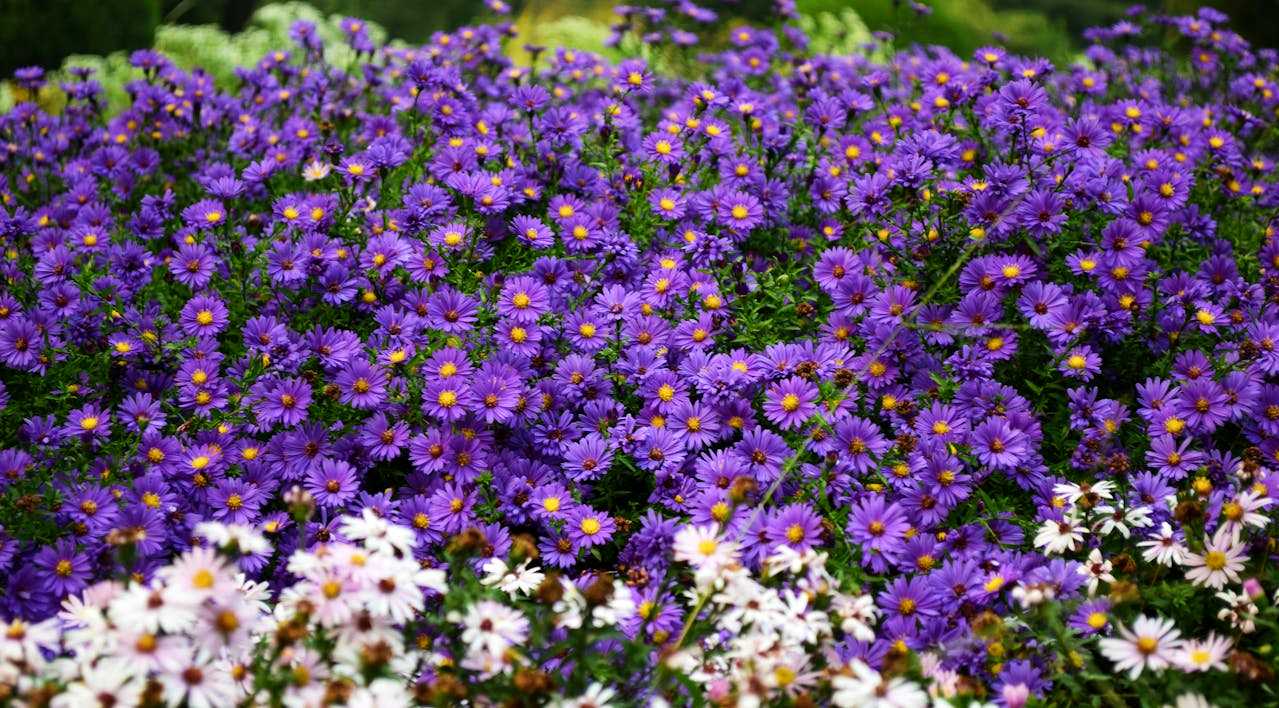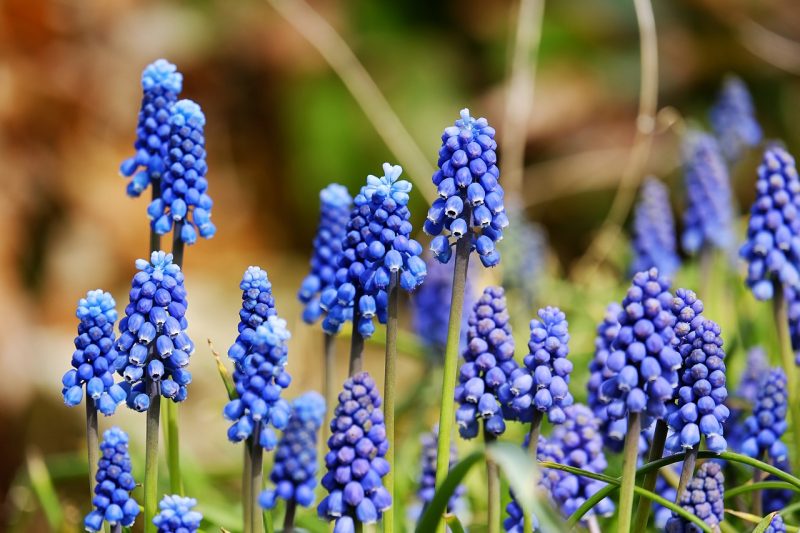As the leaves begin to turn and the air cools, fall presents an opportune time for planting perennials. The cooler temperatures allow plants to establish their root systems without the stress of extreme heat, paving the way for vibrant blooms in the following spring. Each of these stunning plants adds unique charm to the garden and thrives when planted during the autumn months.
Allium, Ornamental Onion
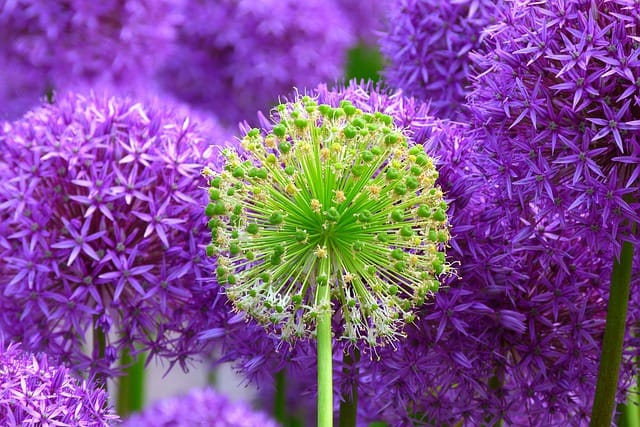
Alliums, commonly known as ornamental onions, are bold perennials that can transform any garden space into a veritable spectacle of color and form. With over 300 species, Allium includes varieties that boast striking round flower heads and slender, upright foliage. When planted in the fall, these bulbous wonders benefit from the moist soil conditions that promote root development before the colder months set in.
Choosing the right Allium variety can make a significant impact on your garden design. For instance, Allium giganteum reaches a height of up to four feet and produces large purple globe-shaped blooms, while Allium moly offers a more compact size with bright yellow flower clusters. Planting Alliums in clusters can create visual interest and allow for effective naturalization, as they tend to multiply over the years, filling your garden with spectacular hues.
Additionally, Alliums are loved not only for their beauty but also for their resilience against garden pests. The onion-scented foliage can deter deer and rabbits, making it a practical choice for gardeners seeking low-maintenance options. To plant, select a sunny location with well-draining soil and a depth of around two to four times the bulb’s height. With proper care, Alliums will reward you with eye-catching displays year after year.
Anemone
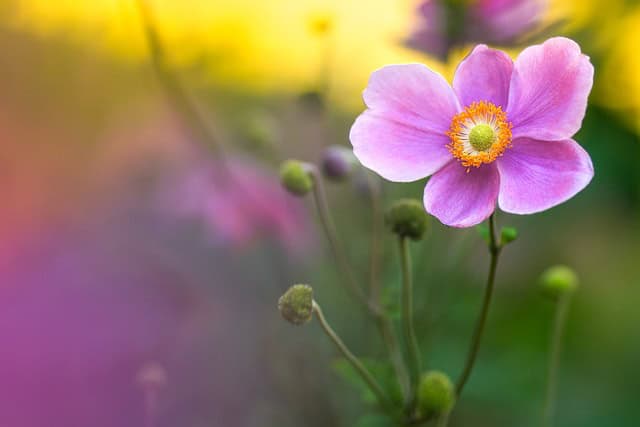
Anemones are delightful perennials that bloom in late summer to fall, making them an excellent addition to your autumn garden. Among the wide variety of species available, Anemone x hybrida, often referred to as Japanese anemone, is particularly beloved for its graceful, delicate flowers that sway elegantly on tall, slender stems. These perennial gems are ideal for planting in fall, allowing them to get established before the full bloom in the following season.
Planting Anemone in fall gives them a head start for their growth cycle, as they thrive best in a rich, moist, and well-drained soil enriched with organic matter. They appreciate partial shade to full sun, but during the heat of the summer, some afternoon shade can ensure they don’t suffer from drought stress. With varieties offering colors from pure white to deep pinks and vibrant purples, Anemones can seamlessly blend into various garden palettes.
In addition to their beauty, Anemones are favored for attracting pollinators, such as bees and butterflies, providing crucial support to local ecosystems. Their long-lasting blooms can serve as a focal point in your fall garden design, even when other plants have started to fade. Whether planted in borders, as ground cover, or within mixed perennial gardens, Anemones provide a refreshing burst of color and elegance as summer transitions into autumn.
Aster
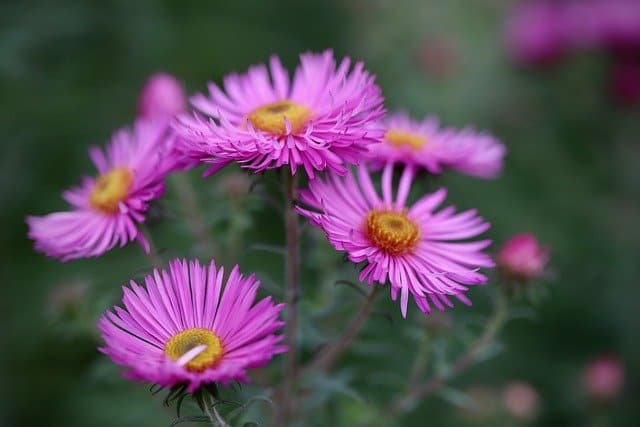
Asters are native fall perennials that bring bursts of color to the late-season garden, blossoming in hues that range from soft pastels to vibrant shades of purple, blue, and even white. Known for their daisy-like flowers that bloom abundantly in late summer and early fall, these perennials are a must-have for any garden looking for seasonal interest. Planting Asters in fall allows their root systems to establish well before winter, ensuring a robust display of flowers come frost-free days.
The most commonly grown types are Aster novae-angliae (New England Aster) and Aster novae-belgii (New York Aster). New England Asters can reach heights of up to four feet and are especially attractive to pollinators, making them an excellent choice for wildlife gardens. Planting them in clusters amid ornamental grasses or other perennials can create a beautiful tapestry of colors.
Asters thrive in well-drained soil, and they prefer full sun conditions to produce their most vibrant blooms. When planted in the fall, it’s important to ensure that they receive adequate moisture during their establishment period, particularly in the autumn months. Not only do they provide a late-season flourish for the garden, but they also serve as crucial food sources for migrating monarch butterflies and other pollinators, making your garden a vital link in the ecological chain during the transition to cooler months.
Astilbe
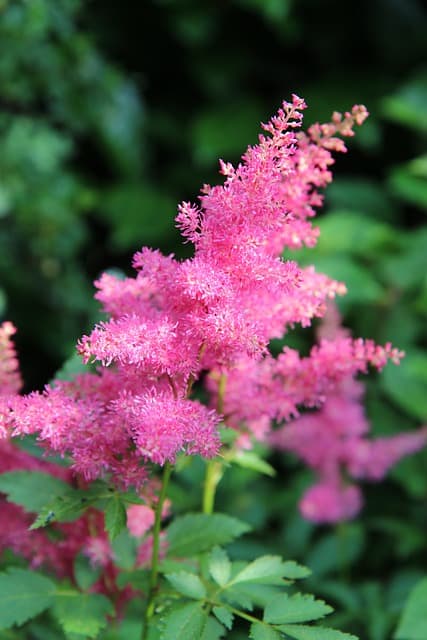
Astilbe is a fabulous perennial that brings a lush, romantic touch to any shaded area in your garden. With its feathery plumes, which can reach heights of up to four feet, Astilbe adds texture and visual interest. The blooms come in various colors, including white, pink, red, and lavender, providing a vibrant display that can enhance the beauty of shady corners or partially sunny spots.
Fall is an ideal time to plant Astilbe because it allows the plant to establish a strong root system before the dormant winter months. Astilbe prefers moist, well-drained soil and benefits from a layer of organic mulch to retain moisture and prevent weed growth. When planted in the fall, these perennials start to bloom as early as late spring, creating a delightful spectacle that signals the onset of warmer weather.
One of the charming aspects of Astilbe is its ability to attract pollinators such as bees and butterflies, making it beneficial for the ecosystem. This perennial also complements other shade-loving plants, such as hostas or ferns. Moreover, their beautiful foliage, which can turn bronze or red in autumn, adds to the seasonal appeal of your garden. With minimal care and the right conditions, Astilbe will thrive for years, ensuring that your garden remains lush and inviting.
Azaleas

Azaleas are classic perennials that bring extraordinary visual impact and charm to any landscape, especially in spring. As deciduous or evergreen shrubs, they showcase an array of colors and flowering types, making them popular choices among gardeners. Planting Azaleas in the fall allows them ample time to establish deep root systems before the harsh temperatures of winter.
Typically, Azaleas prefer acidic, well-drained soil and a location that offers some protection from harsh afternoon sun. When planting these perennials, consider their mature size and spacing to ensure good air circulation and light penetration, which helps avoid diseases such as powdery mildew or root rot.
In addition to their beautiful blooms—ranging from soft pastels to fiery reds and purples—Azaleas are particularly valued for their overall structure and foliage. In many varieties, the leaves can remain attractive throughout the year, and many evergreen types provide winter interest. Some Azaleas also feature delightful fragrances, adding an olfactory dimension to your garden experience.
Planting Azaleas in fall is not only practical for their establishment but also beneficial for biodiversity, as they attract butterflies and other pollinators during their blooming season. When planted in groups, they create a sweeping display of color that can serve as a stunning focal point or hedge in your landscape. With proper care, Azaleas can thrive for decades, providing generations of beauty to your garden.
Basket-of-Gold

Basket-of-Gold, scientifically known as Aurinia saxatilis, is a charming and resilient perennial that offers a splash of gold to your garden in early spring. As a low-growing evergreen, it’s particularly suited for rock gardens, borders, and containers, making it a versatile choice for various garden designs. Fall planting allows the Basket-of-Gold to develop a robust root system before the winter dormancy sets in.
This perennial thrives in well-drained soil and prefers full sun, making it an excellent option for sunny spots. The bright yellow flowers of Basket-of-Gold appear in dense clusters atop fleshy, gray-green foliage, creating stunning drifts that can light up areas of your garden. Their striking hue not only attracts pollinators such as bees but also provides fantastic contrast to darker-hued perennials and shrubs.
One compelling feature of Basket-of-Gold is its drought tolerance once established, making it an ideal plant for xeriscaping or low-water gardens. Its compact growth habit and ability to spread make it an excellent choice for cascading arrangements or ground cover, suppressing weeds while adding vibrant color to the landscape.
Additionally, its adaptability to poor soil further enhances its appeal, allowing gardeners with diverse soil conditions to include this perennial in their plantings. Planting Basket-of-Gold in the fall gives them the chance to settle in and prepare to put on a dazzling show in the spring, joining the blossoming of other early bloomers and ushering in the season with brilliance.
Black-Eyed Susan
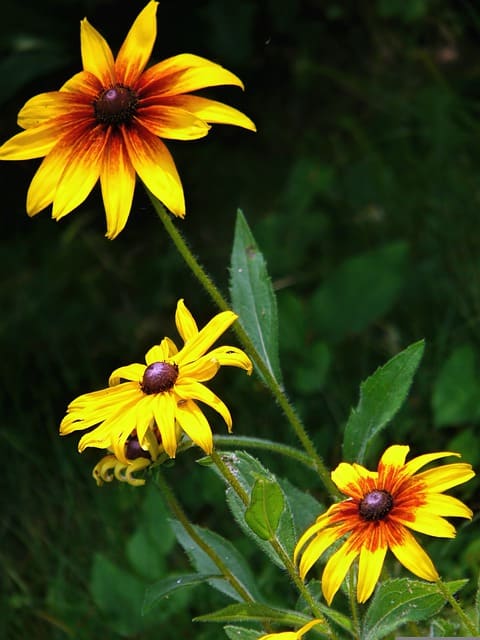
Black-Eyed Susan (Rudbeckia hirta) is a perennial favorite among gardeners, known for its cheerful, sunny yellow petals surrounding a deep, dark brown central disc. This hardy plant flourishes in full sun and is remarkably tolerant of a variety of soil types, making it an excellent choice for novice and experienced gardeners alike. Planting Black-Eyed Susans in the fall allows them to establish root systems that will sustain them through winter, leading to robust growth and abundant blooms during the warmer months.
These resilient perennials thrive in bright sunlight and can tolerate drought, making them a perfect addition to gardens with less reliable watering regimes. They produce their iconic blooms from mid-summer through fall, providing a continuous display of color that attracts pollinators such as bees and butterflies. Their sturdy stems and rich green foliage create an attractive backdrop for other plants, making them perfect for mixed borders and perennial gardens.
Moreover, Black-Eyed Susans are known for their self-seeding ability, which means they can spread and naturalize beautifully in your landscape. This makes them a fantastic choice for adding a splash of happiness in meadows or informal garden settings. When planted in groups, they create a stunning sea of gold that can brighten any landscape, and their seed heads also provide winter interest and food for birds once the growing season ends.
Bleeding Heart
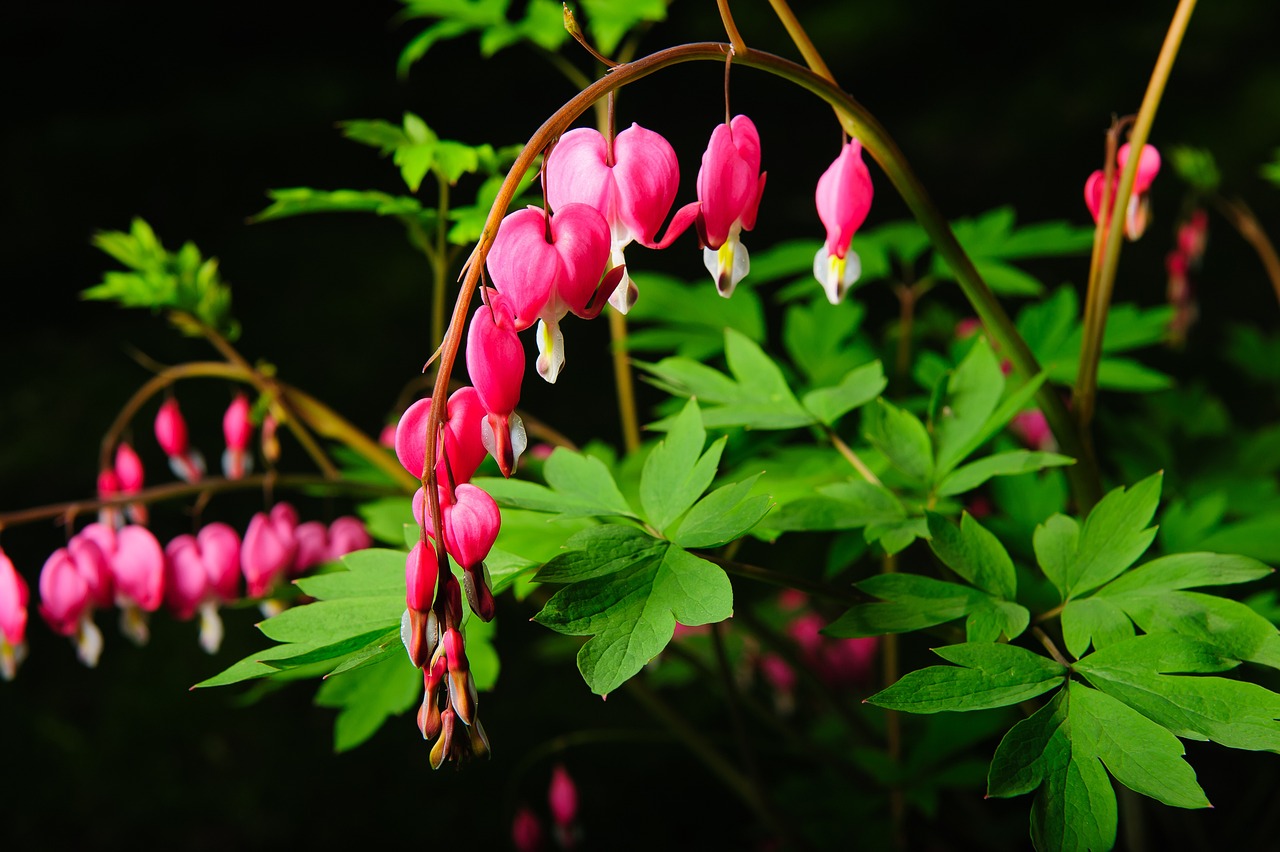
Bleeding Heart (Dicentra spectabilis) is a perennial known for its unique and delicate heart-shaped flowers that dangle gracefully from arching stems. This plant is particularly well-suited for partial shade, making it an excellent option for gardens with dappled sunlight or areas that receive only a few hours of direct sunlight each day. Planting Bleeding Hearts in the fall gives them an excellent opportunity to develop strong root systems before winter, ensuring a breathtaking display of blooms in spring.
The blooms of Bleeding Heart typically appear in late spring and last through early summer, creating a stunning visualization that can evoke feelings of romance and nostalgia. The flowers, which can range in color from the traditional pink to white or even yellow, are not only beautiful but also attract various pollinators. Additionally, the lush, fern-like foliage adds a lushness to shaded garden areas and creates an attractive backdrop for other plants.
Bleeding Hearts thrive in moist, well-drained soil rich in organic matter. Given their preference for cooler planting conditions, establishing them in the fall allows the plant to acclimate and flourish come springtime. These plants are relatively low maintenance and will reward you with delightful blooms year after year, making them a lovely addition to woodland gardens or traditional cottage flowerbeds.
Blue False Indigo
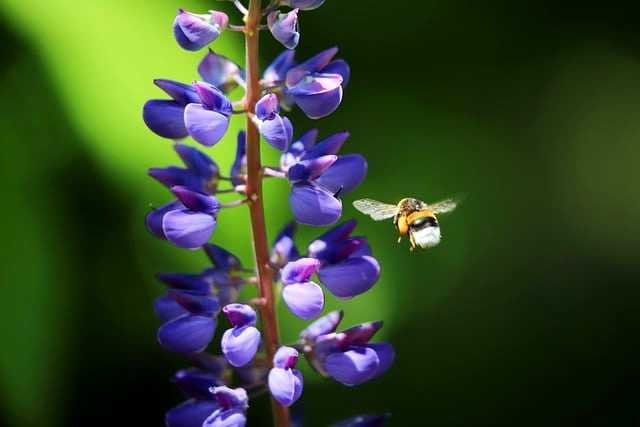
Blue False Indigo (Baptisia australis) is a striking perennial that brings a sense of elegance and rugged robustness to any garden. Known for its spectacular spikes of blue to indigo flowers that resemble those of true indigo (but are not actually related), this plant stands tall and proud, showcasing a stunning display during early to mid-spring. Fall is an excellent time to plant Blue False Indigo, giving it the chance to establish itself and develop a strong root structure prior to the onset of winter.
This hardy perennial thrives in well-drained soil and full sun to partial shade, making it versatile enough to adapt to varying garden conditions. The plant is particularly drought-tolerant once established, making it an ideal choice for low-maintenance gardens. Its striking foliage—often dark green and clover-like—remains attractive throughout the growing season and adds visual interest even when the flowers have faded.
In addition to being visually stunning, Blue False Indigo is a great benefit to local ecosystems, as its blooms attract butterflies, hummingbirds, and other pollinators. Plus, its seed pods add architectural interest to the garden in the fall and winter months, providing further seasonal appeal. Best of all, Blue False Indigo rarely requires staking, making it an easy and reliable choice for gardeners looking to create a lovely perennial display.
Butterfly Bushes
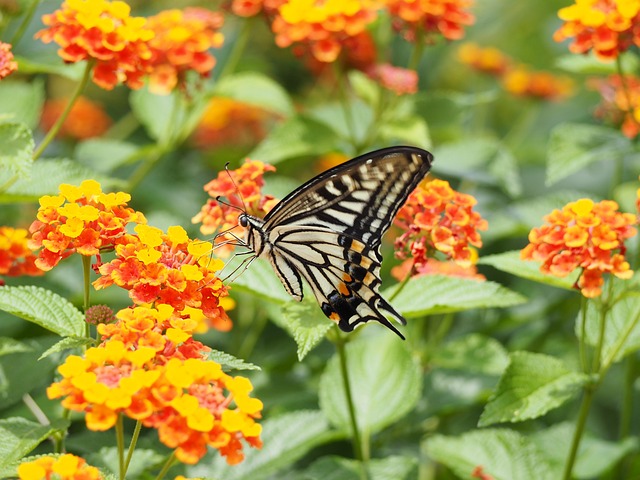
Butterfly Bushes (Buddleja davidii) are renowned for their abundant, fragrant blooms that attract butterflies, bees, and hummingbirds, making them a beloved choice for pollinator-friendly gardens. These deciduous shrubs can grow quite large, often reaching heights of 5 to 10 feet, depending on the specific variety. When planted in the fall, Butterfly Bushes have the opportunity to establish robust roots during the cooler months, leading to impressive growth and flowering in the following summer.
Available in an array of colors, including lavender, dark purple, white, and even yellow, Butterfly Bushes bloom from midsummer through fall, providing a continuous source of nectar for pollinators during this critical feeding period. Their long, arching flower spikes add elegance to the garden, and their fragrant blooms can fill your outdoor space with a delightful scent.
Butterfly Bushes thrive in full sun and well-drained soil, making them versatile plants suitable for various landscapes, including sunny borders, cottage gardens, or as focal points in larger plots. Additionally, they are relatively drought-tolerant once established, reducing maintenance needs and making them an ideal plant for less frequently watered areas. Pruning these shrubs in late winter or early spring encourages healthy growth and keeps their shape in check, allowing for a neat and attractive garden appearance. By ensuring these plants are properly mulched just before the cold sets in, you can help them weather the winter and ensure they produce a spectacular display of blooms come summer.
Caryopteris
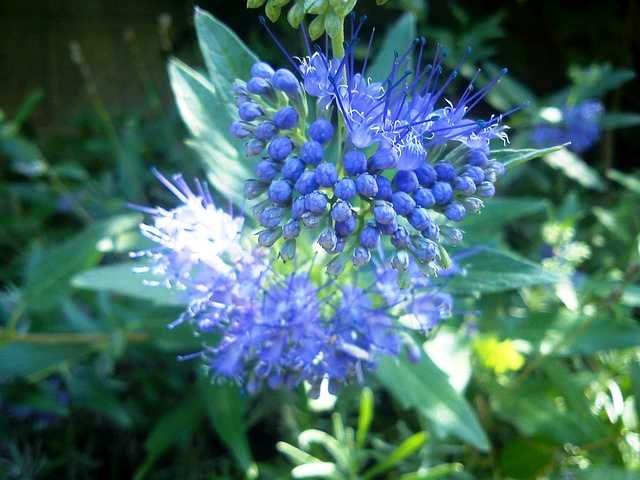
Caryopteris, commonly known as Bluebeard or Blue Spirea, is a delightful perennial shrub that offers a captivating display of blue flowers in late summer to early fall. This plant is a hardy option that thrives in sunny conditions and is adaptable to various soil types, making it a great choice for gardeners looking for low-maintenance additions. Planting Caryopteris in the fall allows it time to settle in and build strong roots, ensuring a vibrant performance and resilience in the following growing season.
Typically reaching heights of 2 to 3 feet, Caryopteris has striking gray-green foliage that beautifully contrasts with its brilliant blue blooms, creating a stunning visual appeal in garden settings. Its flowers are not only eye-catching but are also highly attractive to pollinators, including bees and butterflies, which makes it a fantastic addition to any wildlife garden.
One of the standout features of Caryopteris is its drought tolerance after establishment, making it an excellent option for xeriscaping and regions where water conservation is important. The aromatic leaves, when crushed, release a pleasant scent, adding to the sensory experience of the garden. Caryopteris requires minimal pruning in the spring, just before new growth begins, to maintain its shape and encourage abundant flowering. This perennial shrub is equally stunning when planted in groups or as part of mixed borders, providing a lovely transition between herbaceous perennials and taller shrubs.
Chrysanthemums
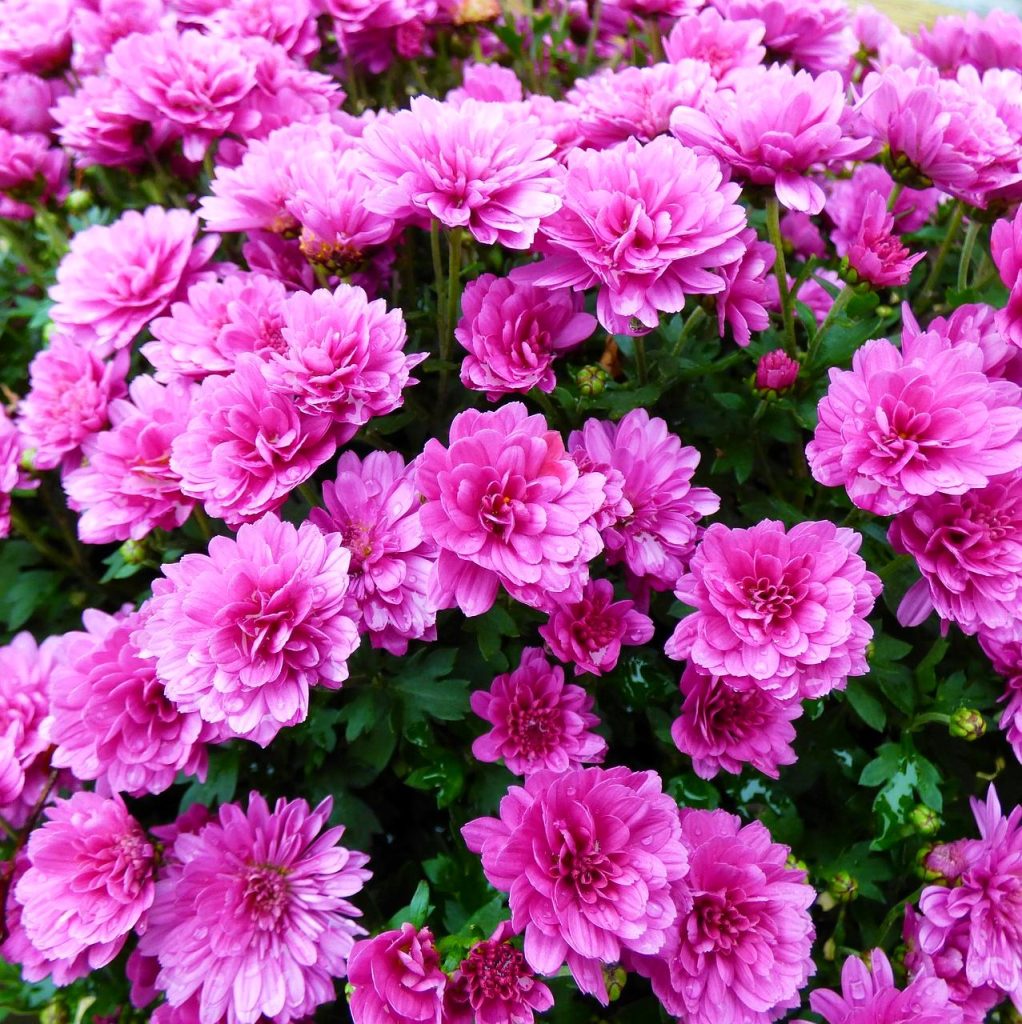
Chrysanthemums, often referred to simply as “mums,” are a quintessential autumn staple that brings vibrant color to gardens just as many plants begin to fade. With a broad range of colors and forms—including decorative features like pom-poms and daisy shapes—Chrysanthemums are perfect for adding a festive flare to fall landscapes. Planting these perennials in the fall allows them to develop a well-established root system before winter dormancy, leading to spectacular blooms the following year.
Typically, Chrysanthemums flourish in full sun and well-draining soil, and they prefer temperatures that aren’t too extreme. When planted in fall, it’s crucial to provide consistent moisture until the ground freezes, allowing roots to take hold. These perennial plants bloom in various colors, including vibrant yellows, oranges, whites, and purples, complementing the autumnal palette beautifully.
In addition to their visual appeal, Chrysanthemums are hardy plants that can withstand cooler temperatures, often continuing to bloom until the first hard frost. They are also excellent for attracting pollinators like bees, providing crucial food sources as they prepare for winter. Once the blooms fade, the foliage continues to provide interest with its green leaves turning brown, which can add textural diversity even in dormant seasons.
Chrysanthemums benefit from deadheading, which encourages more blooms as well as pruning back in late fall to maintain a neat appearance and protect the plant during winter. These versatile perennials are perfect for creating stunning borders or container displays, making them ideal for anyone looking to brighten up their garden at the tail end of the growing season.
Clematis
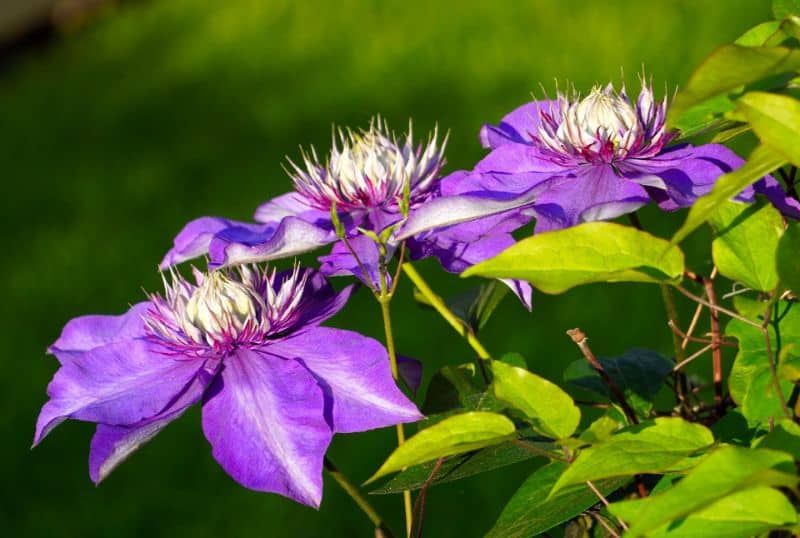
Clematis is a beloved flowering vine known for its spectacular blooms that can transform fences, trellises, and arbors into stunning vertical gardens. With a vast array of varieties, you can find Clematis in sizes, colors, and flowering patterns to suit nearly any garden style. Planting Clematis in the fall allows these dynamic plants to establish robust roots and acclimatize to their environment before the rigors of winter set in.
When selecting a Clematis variety, it’s essential to consider the flowering period, which can range from early spring to late summer. Some varieties bloom on old wood, while others bloom on new growth, so understanding the plant’s growth habits can enhance your success. Most Clematis thrive in well-drained soil with a preference for full sun to partial shade, but they also appreciate their roots being kept cool, often achieved by mulching around the base.
One alluring aspect of Clematis is its ability to climb and intertwine with other plants, making it ideal for creating lush, layered visuals in your garden. Its flowers are not only visually captivating but also attractive to pollinators, enhancing biodiversity in your landscape. Clematis is also relatively low-maintenance once established, requiring periodic pruning to encourage forthworthy blooms each season. By planting in the fall, you provide these climbers the chance to settle in, appropriately preparing them for an impressive floral display come spring.
Columbine
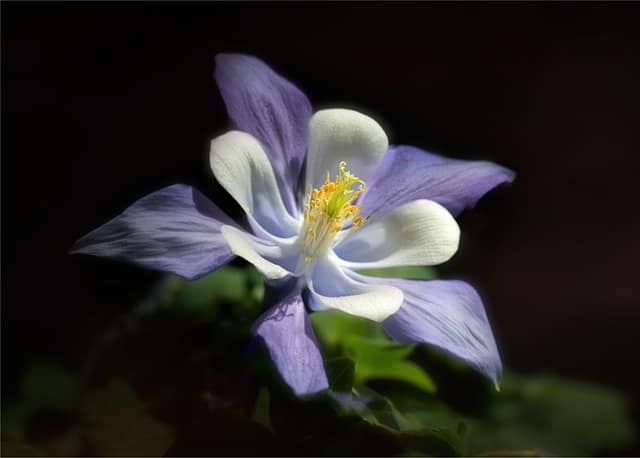
Columbine (Aquilegia) is a charming perennial that captivates with its delicate, nodding blooms resembling spurred bells. These unique flowers come in a palette of colors, including blue, purple, red, and yellow, often displaying intriguing bicolored varieties. Fall is a favorable time to plant Columbine, as it allows the plants to establish their roots before winter, leading to an early bloom the following spring.
These perennials thrive in well-drained soil and prefer partial shade, making them perfect for woodland gardens or shaded borders. While Columbine is tolerant of drought, they generally perform best with moderate watering, especially during the hot summer months when they are actively growing. Their unique flower shape not only adds a delightful touch to the garden but also acts as a magnet for hummingbirds and beneficial insects, promoting a healthy and vibrant ecosystem.
Columbine’s foliage also offers ornamental value throughout the growing season, with its attractive, deeply lobed leaves providing a lush green backdrop for other flowers. In addition, these plants are perennial and can self-seed, which means you can expect them to return year after year, bringing natural charm and whimsy to your garden. To keep your Columbine thriving, it’s advisable to mulch around them to retain moisture and suppress weeds, enhancing their longevity and vigor.
Coneflower
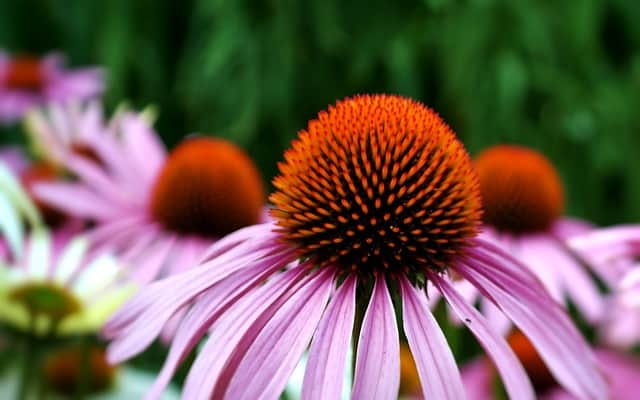
Coneflower (Echinacea) is a staple in perennial gardens, known for its striking daisy-like flowers with prominent, cone-shaped centers. This robust plant stands out with its vibrant pink, purple, and white blooms, which appear from summer to early fall, creating a cheerful atmosphere in any garden setting. Planting Coneflowers in the fall allows ample time for their roots to establish before winter, leading to profuse flowering in the subsequent growing season.
These perennials thrive in full sun and well-drained soil, making them highly adaptable and resilient against drought conditions once established. Their tough nature makes Coneflowers a favorite among gardeners looking for low-maintenance, long-lasting blooms. Moreover, Coneflowers are valuable in attracting pollinators like bees and butterflies, which are crucial for a healthy garden ecosystem.
An appealing aspect of Coneflower is its versatility; they perform beautifully in borders, wildflower gardens, or mixed beds and can make stunning cut flowers for bouquets. Additionally, the spent flowers provide food for birds during the fall and winter months, enhancing your garden’s appeal even after the growing season comes to an end. To encourage bushier growth and more blooms, it’s recommended to deadhead regularly and to divide mature plants every few years, promoting vitality and ensuring they continue to flourish.
Coral Bells

Coral Bells (Heuchera) are celebrated for their stunning foliage that adds texture and color to the garden throughout the year. With leaves ranging from deep burgundy and purple to bright green and silver, these versatile perennials can complement any garden aesthetic. Fall planting of Coral Bells is particularly advantageous, as this is when the cooler temperatures encourage root development, leading to vigorous growth in spring.
In addition to their varied color palette, Coral Bells produce delicate flower spikes adorned with tiny bell-like blooms in shades of white, pink, or red, blooming primarily in late spring to early summer. These flowers attract pollinators such as bees and hummingbirds, contributing to a lively and dynamic garden. Coral Bells thrive in well-drained soil and prefer partial sun to shady conditions, making them ideal for adding color to shaded spots, under trees, or along pathways.
One of the remarkable features of Coral Bells is their ability to tolerate a variety of soil conditions, as long as they are not waterlogged. Their evergreen foliage, which may vary by variety, can provide continuous interest, transitioning beautifully through the seasons. To maximize their visual impact, consider planting them in clusters or along borders, where their extravagant colors can shine against the backdrop of green. The fall season is an excellent time to give these perennials a head start, allowing them time to take root before the winter chill settles in.
Coreopsis
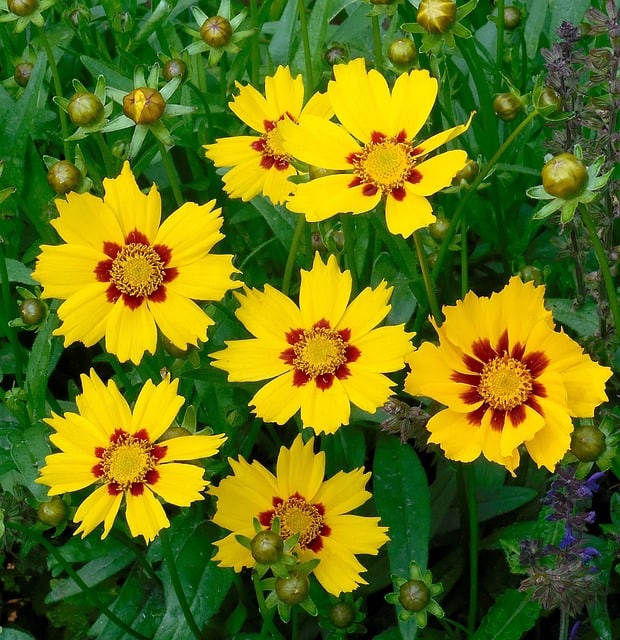
Coreopsis, commonly known as tickseed, is a delightful perennial that offers a profusion of bright, sunny blooms throughout the summer and into early fall. Characterized by their daisy-like flowers in shades of yellow, gold, and orange, Coreopsis adds a cheerful touch to any garden. Planting Coreopsis in the fall is beneficial for these hardy sun-lovers, as it allows them to stabilize their root systems before the cold sets in, leading to a more robust display of flowers come late spring and summer.
These perennials thrive in full sun and well-drained soil, making them perfect for borders, wildflower gardens, and even as ground cover due to their spreading habit. Coreopsis is remarkably tolerant of drought and poor soil conditions, which means they require minimal maintenance once established. This resilience makes them a great choice for gardeners seeking low-maintenance options that still deliver stunning seasonal blooms.
Coreopsis not only brightens up the garden but also attracts a whole host of pollinators, including butterflies and bees, enhancing the ecological health of your landscape. To encourage more prolific blooms, regular deadheading of spent flowers is encouraged, promoting continual flowering throughout their growing season. Their ability to self-seed can also help them spread and naturalize in your garden, bringing an organic feel to your landscape. By planting Coreopsis in the fall, you set the stage for a vibrant, welcoming garden that continues to flourish with color and life.
Crown Imperial

Crown Imperial (Fritillaria imperialis) is a truly unique perennial that stands out not only for its striking appearance but also for its historical significance and evolutionary adaptations. With tall, stately spikes that can reach up to 4 feet high, Crown Imperial features clusters of drooping, bell-shaped flowers—often in vibrant shades of orange, yellow, and red—crowned by a tuft of regal foliage at the top. This eye-catching plant creates a dramatic focal point in any garden. Fall is an ideal time to plant Crown Imperial bulbs, allowing them to settle in and establish roots before the frost, ensuring they produce their magnificent blooms in the spring.
One of the unique characteristics of Crown Imperial is its distinct fragrance and the fact that it exudes a natural property that deters certain pests from garden areas, making it not only an attractive choice but also a functional one. These plants thrive in well-drained soil and prefer full sun to partial shade, often reaching their full flowering potential in rich garden beds or mixed borders where their height can provide a stunning vertical element.
Crown Imperial blooms during the spring, typically around April to May, and their exotic flowers are known to attract butterflies and other pollinators. After flowering, the foliage remains attractive for several months before dieback, providing a lush background for other summer blooms. It’s worth noting that these perennials can take a few seasons to reach full maturity and flower profusely, so patience is key. However, the dramatic effect they provide in the garden is truly worth the wait.
Daylilies
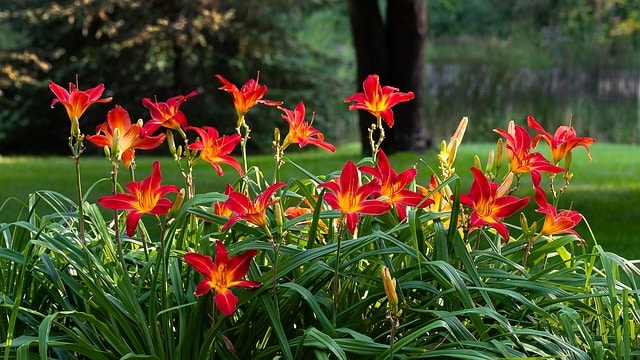
Daylilies (Hemerocallis) are renowned for their vibrant, trumpet-shaped flowers that bloom profusely throughout the summer. With an incredible variety of colors and patterns, these hardy perennials can create a spectacular display in any garden. Planting Daylilies in the fall allows them to settle into the soil and establish a strong root system before the cold winter sets in, leading to a robust and colorful show when spring arrives.
One captivating aspect of Daylilies is their remarkable resilience. They thrive in diverse soil types and can tolerate both drought and heat, making them perfect for low-maintenance gardens. These plants also multiply over time, producing more blooms and enriching the overall visual appeal of your landscape with their lush, grassy foliage. Daylilies generally prefer full sun, but they can tolerate light shade, providing flexibility in garden placement.
The blooms of the Daylily are ephemeral, lasting only one day; however, each plant produces numerous flower buds, ensuring a continuous display over several weeks. Furthermore, Daylilies are ideal for naturalizing, as they adapt well to different environments and can bloom even in less-than-optimal conditions. When planted in groups, they create a vibrant tapestry of color, making them a perfect choice for borders, cottage gardens, or mixed perennial beds.
Dogwoods
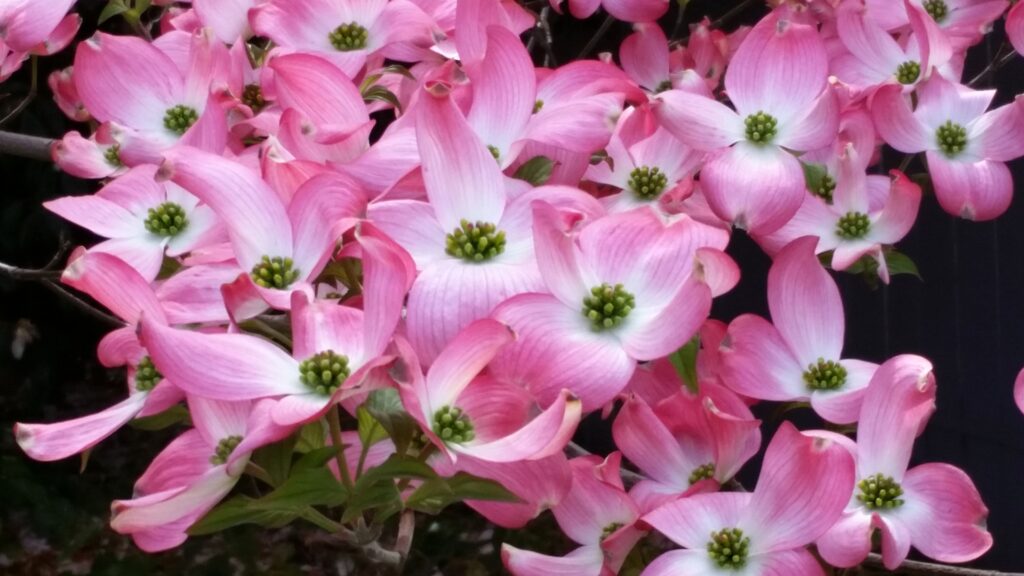
While often associated with trees and shrubs, certain species of Dogwoods (Cornus) can serve as beautiful perennial additions to your garden. Particularly, the hybrid varieties and dwarf species offer stunning blooms and decorative foliage. Planting Dogwoods in the fall provides them with an ideal timeframe to develop deep roots, ensuring they thrive when the growing season resumes.
Dogwoods are appreciated for their brilliant spring flowers, which can vary from white to pink, and their visually striking berries that emerge in the fall, attracting various birds and wildlife to your garden. Furthermore, their leaves often exhibit vibrant fall colors, adding another layer of interest to your landscape. The variety of Dogwoods available means you can find one to suit your specific garden needs, whether you desire a flowering shrub or a tree that provides structure and shade.
These plants generally prefer well-draining, moist soil and thrive in partial shade, making them perfect for woodland gardens or as understory plants amidst larger trees. Planting Dogwoods in groups can create a stunning visual display, especially during the spring bloom period. To ensure success, it’s essential to provide adequate mulch around their base, helping to retain moisture and regulate soil temperature. This practice promotes healthy root development and reduces the risk of weed competition.
Forsythia
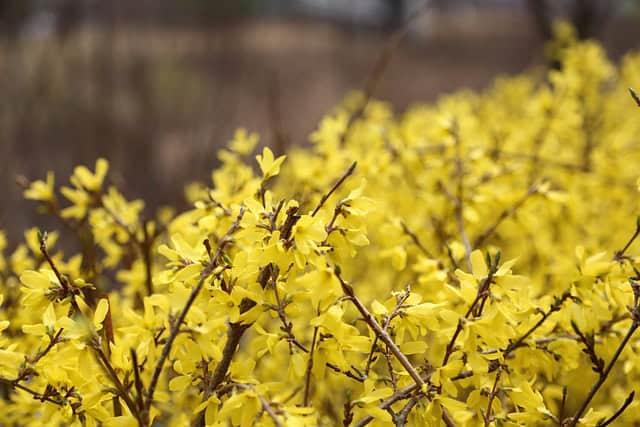
Forsythia is one of the first signs of spring in many gardens, known for its vibrant yellow blossoms that emerge before the leaves appear. Planting Forsythia in the fall gives this striking deciduous shrub ample time to establish roots, allowing it to burst forth with abundant blooms when spring comes. With its cheerful and bright flowers, Forsythia is perfect for adding a pop of color to any landscape.
This hardy shrub is relatively low-maintenance and grows well in a variety of soil types, making it an excellent choice for both novice and experienced gardeners. Forsythia can grow into a large shrub, reaching heights of 8 to 10 feet, providing a natural privacy screen or windbreak if planted in groups. Furthermore, its arching branches create an attractive visual appeal, especially when they are covered in a blanket of yellow flowers at the start of the growing season.
Forsythia thrives in full sun to partial shade and prefers well-drained soil. To promote healthy growth, regular pruning after flowering helps maintain its shape and encourages bushy growth, resulting in more flowers in the following year. The foliage that follows the flowers turns a lush green in summer and showcases shades of yellowish-brown in fall, creating a year-round visual interest in the landscape.
Grape Hyacinth
Grape Hyacinth (Muscari) is a charming bulb perennial that brings a delightful splash of color to the spring garden. Known for their dense clusters of tiny, bell-shaped flowers resembling grape clusters, these diminutive plants come in shades of blue, purple, and white, creating an enchanting carpet of blooms. Planting Grape Hyacinths in the fall allows the bulbs to establish roots during the cool months, ensuring a brilliant display when they emerge in early spring.
Grape Hyacinths thrive in well-drained soil and enjoy full sun to partial shade, making them versatile enough to fit into various garden settings, from rock gardens to mixed borders. Their compact stature, usually standing about 6 to 12 inches tall, makes them an excellent choice for filling in gaps and adding depth beneath taller perennials. Once established, these bulbs will naturalize, multiplying over the years and rewarding gardeners with broader swathes of color.
In addition to their aesthetic appeal, Grape Hyacinths are excellent for pollinators, attracting bees and butterflies eager for nectar in early spring. They also work well in combination with other spring-blooming bulbs, creating a picturesque scene that heralds the arrival of warmer weather. Plant these bulbs in clusters for the most impact, where they can create a delightful sea of color that enchants your garden.
Hellebore
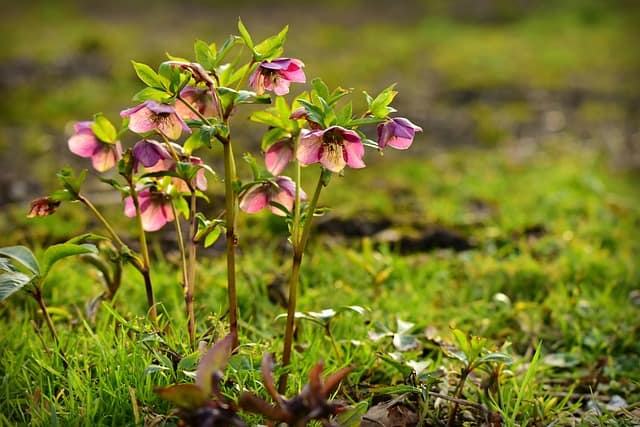
Hellebore, often referred to as the “Lenten Rose,” is a unique perennial renowned for its early spring blooms, which can emerge even when snow is still on the ground. The leathery leaves give way to stunning flowers in shades of white, pink, purple, and green, making them an extraordinary choice for those looking to add early-season interest to their gardens. Planting Hellebores in the fall allows them to acclimate to their surroundings, leading to strong root systems that ensure a vibrant display come spring.
These perennials thrive in shade to partial shade, making them perfect for woodland gardens or shaded borders where other plants may struggle. Hellebores prefer moist, well-drained soil enriched with organic matter, allowing their roots to establish without the stress of competing with weeds. Once established, they require minimal care and can thrive for many years, often becoming a staple in any garden space.
One of the most endearing aspects of Hellebores is their extended flowering period. Depending on the variety, blooms can last from late winter all the way through early spring, providing a much-needed splash of color when most other plants are still dormant. Additionally, their seed pods can provide visual interest in the garden even after the blooms have faded, making them a valuable addition year-round. Consider pairing Hellebores with early spring bulbs for a stunning dormancy-breaking display that captivates from the moment the snow thaws.
Hydrangeas
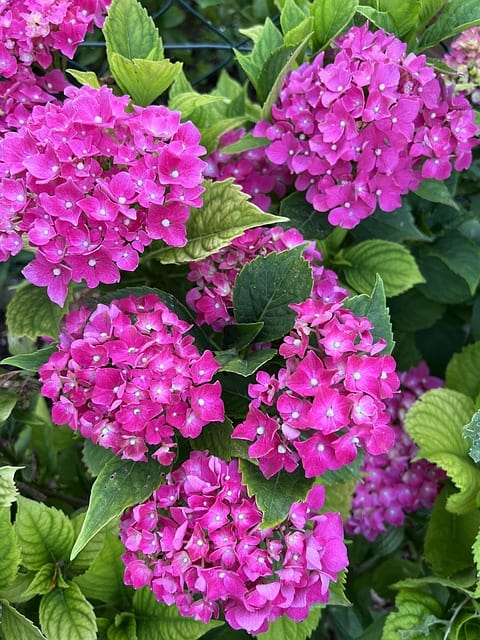
Hydrangeas are among the most versatile and popular perennials, celebrated for their large, showy flower heads that can infuse any garden with color. While many people think to plant hydrangeas in spring, planting them in the fall is equally beneficial. This timing allows roots to take hold during the milder temperatures, providing the plants with an essential head start for the active growing season in spring.
Hydrangeas thrive in various garden conditions, with different varieties adapting well to sun, partial shade, and even shade. Understanding the type of Hydrangea you are planting is crucial, as some prefer moist, well-drained soil while others may have an affinity for more alkaline conditions. With varieties ranging from the popular mophead and lacecap types to the majestic climbing species, there’s a Hydrangea to fit every garden style.
One striking feature of Hydrangeas is their color change, which can be influenced by soil pH levels. For example, the blooms of Hydrangea macrophylla can shift from pink to blue based on soil acidity, adding an interactive element to your gardening experience. Additionally, they provide exceptional cut flowers, making them perfect for arrangements both indoors and out. The lush foliage and colorful blooms make Hydrangeas a focal point in any landscape.
To ensure your Hydrangeas thrive, it’s vital to apply a layer of mulch around their root zone in the fall, helping moderate soil temperature and retain moisture. With appropriate care, these plants will flourish and reward you with a stunning display of color each year, making them a beloved perennial option for fall planting.
Ice Plant
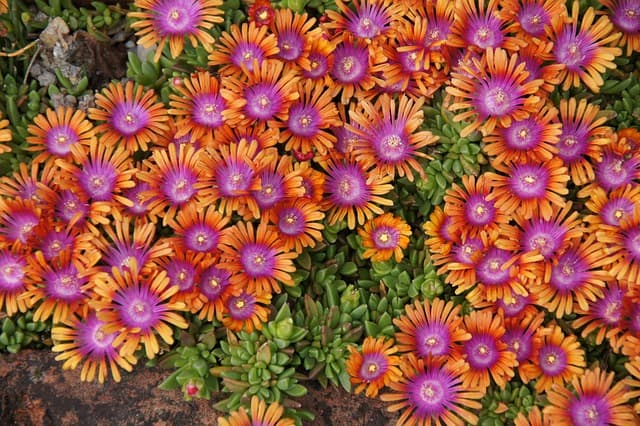
Ice Plant (Delosperma) is a remarkable succulent perennial known for its vibrant daisy-like flowers and drought tolerance. Typically found in colors ranging from bright yellow and orange to more subdued shades of pink and purple, Ice Plant delivers a burst of color that can brighten any rock garden, border, or hanging container. When planted in the fall, Ice Plant has ample time to establish itself before the onset of colder weather, ensuring stunning blooms in the spring and summer months.
Ice Plants prefer well-drained soil and thrive in full sun, making them perfect for arid gardens or areas that receive intense sunlight. Their fleshy leaves are adept at storing water, allowing them to survive in less-than-ideal conditions. This quality not only makes them an excellent choice for xeriscaping but also lowers water usage in your landscape, making them an environmentally friendly option.
An additional benefit of Ice Plant is its ability to attract pollinators, particularly bees and butterflies, which flock to its colorful flowers. Their low-growing habit, generally reaching heights of only 6 to 12 inches, makes them ideal for ground cover or cascading over walls and rocks, where they create an eye-catching display. By planting Ice Plant in the fall, you’ll set the stage for a lively, colorful garden that welcomes a host of beneficial insects as the warm months arrive.
Lambs’ Ear
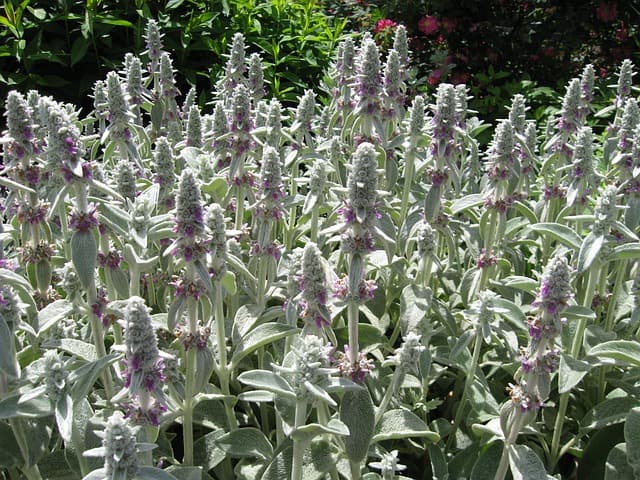
Lambs’ Ear (Stachys byzantina) is celebrated for its soft, fuzzy leaves that resemble the ears of a lamb. This perennial is a delightful addition to gardens, offering both texture and contrast to other plants. Its silvery-green foliage provides a striking backdrop for vibrant flowering plants, and when planted in the fall, Lambs’ Ear can establish its roots in time for a lush display the following spring.
This plant excels in full sun to partial shade and thrives in well-drained soil. It is incredibly resilient, tolerating drought conditions once established, making it ideal for low-maintenance gardens. Lambs’ Ear also spreads readily, which allows it to fill in spaces and create a lovely ground cover that minimizes weeds while enhancing the overall aesthetic of your landscape.
In late spring to early summer, Lambs’ Ear produces tall spikes adorned with purple or pink flowers, which attract bees and other pollinators, helping to support local biodiversity. The combination of the striking foliage and delicate blooms creates a pleasing visual contrast that can elevate any landscape design. Notably, the leaves of Lambs’ Ear are not just ornamental; they are often used in herbal remedies, further enhancing their appeal for gardeners interested in functional plants.
Lamium

Lamium, commonly known as “dead nettle,” is another stellar choice for fall planting among perennial plants. With a reputation for being hardy and versatile, Lamium thrives in a variety of conditions, making it an exceptional ground cover for shaded areas. With striking foliage that may include variegated patterns of silver and green, Lamium adds interest and beauty to shaded corners of your garden, even when it’s not in bloom.
One of the great advantages of planting Lamium in the fall is their ability to spread and fill in garden spaces, helping to suppress weeds. Their creeping growth habit allows them to cover the ground while creating a lush, carpet-like effect. In spring and early summer, the plant attracts pollinators with its charming clusters of tiny flowers, which can range from white to purple or pink, adding seasonal color to otherwise empty areas.
Lamium prefers well-drained soil and performs best in partial to full shade, making it a perfect candidate for woodland gardens or planting beneath trees. Additionally, it exhibits resilience against drought once established, providing a low-maintenance solution for gardeners. The combination of its beautiful foliage and delightful blooms offers a striking visual contrast to the more traditional perennials.
When paired with other shade-loving plants such as ferns or Hellebores, Lamium can create a diverse and lush underplanting that brings life to your garden throughout the seasons. Planting Lamium in the fall ensures that this resilient ground cover will have the time needed to establish itself, resulting in an impressive display the following spring.
Lantana
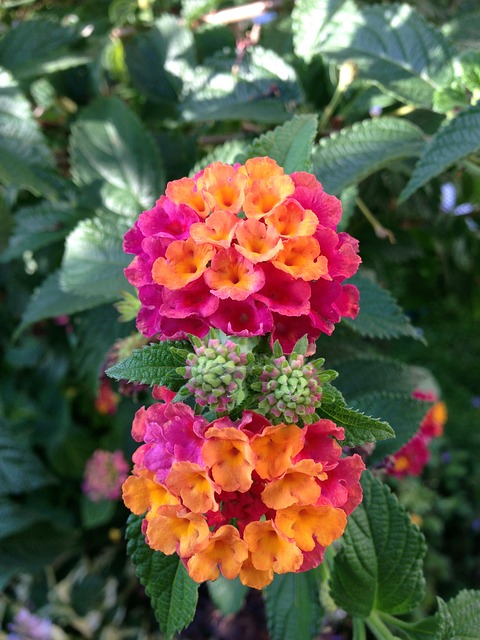
Lantana is a show-stopping perennial celebrated for its vibrant clusters of small flowers that bloom in a range of colors, including fiery oranges, pinks, yellows, and purples. By planting Lantana in the fall, gardeners can provide these hardy plants with the opportunity to root deeply into the soil before winter arrives. This helps them to thrive through the stresses of the next spring and summer, showcasing their colorful blossoms when temperatures rise.
Aside from their visual appeal, Lantanas are incredibly attractive to pollinators, particularly butterflies, who are drawn to their nectar. This makes them an excellent addition for those looking to create a wildlife-friendly garden. Be mindful that Lantana prefers full sun and well-drained soil, allowing it to fully express its growth potential. It is also relatively drought-tolerant, making it a suitable choice for xeriscaping or low-water gardens.
The plant’s growth habit can vary: some species reach a relatively low height of about 1 to 3 feet while others may form sprawling ground covers. Because of this versatility, Lantana can be used effectively in garden beds, as accent plants, or even as cascading options in containers. When planted in clumps, these cheerful blooms create an exquisite burst of color that grabs attention and livens up the landscape.
Lavender
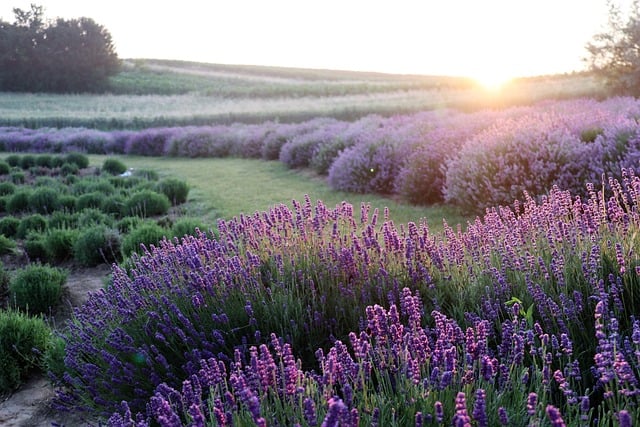
Known for its soothing fragrance and enchanting beauty, Lavender (Lavandula) is a timeless perennial that deserves a spot in any garden. Planting Lavender in the fall allows this aromatic herb to acclimate to its environment and establish a strong root system during the cooler months. Once spring arrives, gardeners can enjoy a magnificent display of purple spikes that are not only visually striking but also fragrant.
Lavender thrives in sunny locations with well-drained, sandy or gravelly soil. This drought-tolerant plant is well-suited for Mediterranean-style gardens and is perfect for those who prefer low-maintenance landscaping. By selecting the appropriate variety of Lavender, gardeners can enjoy flowers from early summer to late fall, providing long-lasting color and texture to their outdoor space.
Beyond its aesthetic charm, Lavender brings numerous benefits to the garden ecosystem. The fragrant flowers attract bees and other pollinators, supporting biodiversity and contributing to a healthy environment. Additionally, the dried flowers can be harvested for use in potpourri, sachets, and culinary dishes, making Lavender both functional and beautiful.
For optimal results, ensure adequate spacing when planting Lavender to enhance air circulation and avoid mildew. A layer of mulch around the plants in fall can help regulate soil temperature and conserve moisture, setting the stage for success in the growing season ahead.
Lenten Rose
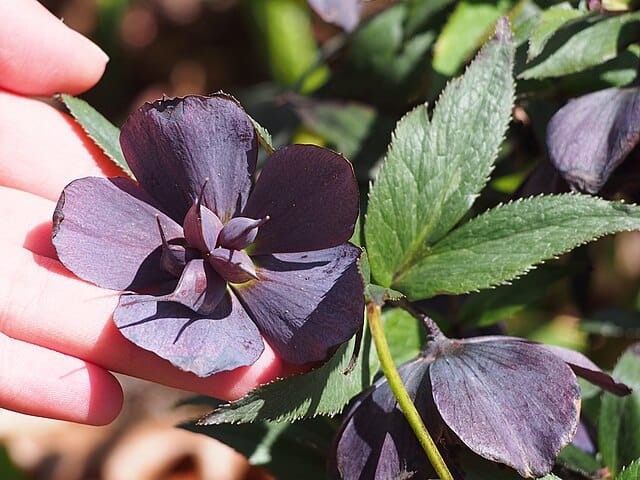
Lenten Rose (Helleborus orientalis), often referred to as Hellebore, deserves its own spotlight as a striking early spring bloomer. While we previously discussed Hellebore, Lenten Rose is a specific and beloved type that offers unique benefits for gardeners. Planting Lenten Roses in the fall allows them to establish their roots, ensuring that these enchanting flowers will bloom beautifully as winter transitions into spring.
These perennials are particularly notable for their elegant, cup-shaped flowers that emerge in late winter to early spring, often braving frost and snow. Their broad, leathery leaves remain attractive throughout the growing season and can provide wonderful ground cover in shady areas. With a wide range of colors from deep purples to soft whites and pinks, Lenten Roses add striking beauty and intrigue to any garden.
Lenten Roses thrive in well-drained, rich, and moist soil, preferring partial to full shade. This makes them ideal for woodland gardens or shaded spots where most other plants may struggle to grow. They are not just beautiful; these plants also attract pollinators, including bees, when they bloom, contributing to biodiversity in your garden.
One of the significant advantages of Lenten Rose is its longevity and resilience. Once established, they can thrive for decades, providing steady blooms and captivating foliage year after year. With minimal care required, these plants can thrive in a variety of conditions, making them an excellent choice for busy gardeners or those looking to add some low-maintenance beauty to their landscape.
Lupine
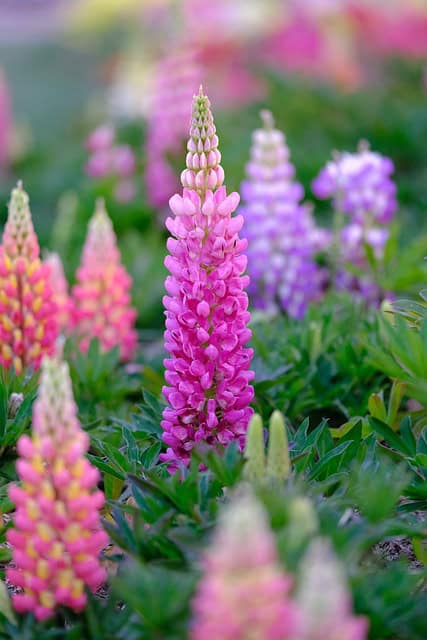
Lupine (Lupinus) is an eye-catching perennial known for its stunning upright flower spikes that come alive in a kaleidoscope of colors, including blue, purple, pink, and white. These charming flowers, often resembling tall, colorful candles, bloom in late spring and early summer, making it a wonderful choice for adding vertical interest to flower beds or borders. Planting Lupine in the fall allows the seeds or transplants to establish roots before winter, paving the way for robust growth and stunning blooms in the following spring.
Lupines thrive best in well-drained soil with good organic matter and prefer full sun to partial shade. They are also relatively drought-tolerant once established, making them an excellent addition to low-maintenance gardens. Their ability to attract bees and butterflies enhances your garden’s pollinator-friendly environment, supporting local wildlife and contributing to ecological diversity.
Moreover, Lupines are beneficial for soil health due to their nitrogen-fixing capabilities. This means they can convert atmospheric nitrogen into a form that is usable by plants, effectively improving soil fertility. For gardeners looking to create a sustainable and thriving ecosystem, incorporating Lupines can be an excellent strategy.
When planting, ensure that you give them enough space, as they can grow tall and wide, reaching heights of 2 to 4 feet. This makes them particularly suited for the back of borders or as a colorful focal point in garden designs.
Mini Daffodil
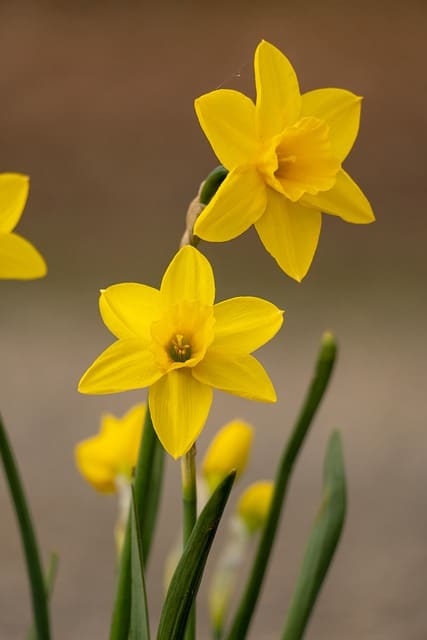
Mini Daffodils (Narcissus spp.) are delightful, smaller versions of their larger counterparts and can add charm and color to any garden. These compact flowers typically bloom in early spring, flaunting their cheerful yellow and white trumpet-shaped blossoms that herald the arrival of warmer weather. Planting Mini Daffodils in the fall allows bulbs to establish a solid root system in the cool, moist soil, ensuring a robust and vibrant display in spring.
These petite daffodils are ideal for small spaces or container gardens, providing a burst of early color without overwhelming more delicate plantings. They prefer well-drained soil and full sun to partial shade, allowing them to thrive in various environments. The best part is that once eventually naturalized, they can multiply over the years, creating lovely clusters that can spread joy and beauty throughout your garden.
Mini Daffodils are also known for their resilience, and because they are deer-resistant, they make an excellent choice for gardens located in areas with browsing wildlife. Additionally, they require minimal maintenance; a little deadheading after blooming will keep them looking tidy.
These cheerful blooms not only provide visual interest, but they are also an excellent choice for creating a spring cutting garden. Use freshly cut Mini Daffodils in arrangements to brighten your home, spreading the joy of spring even indoors.
Oakleaf Hydrangea
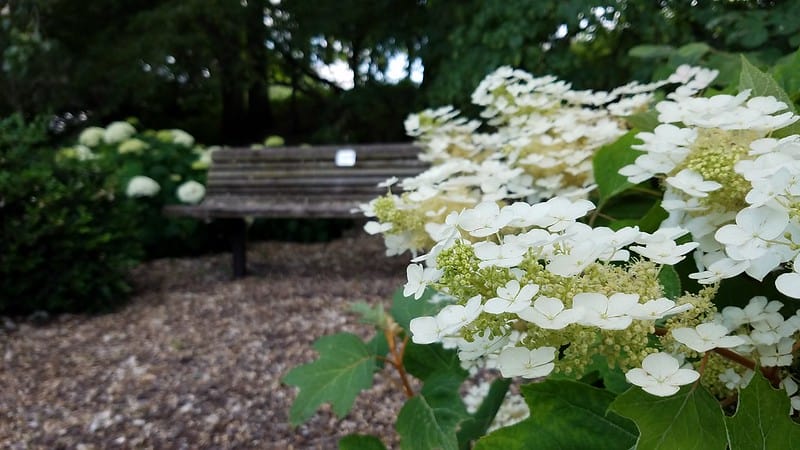
Oakleaf Hydrangea (Hydrangea quercifolia) is a stunning perennial that captivates with its large, oak-like leaves and unique flower heads. This hydrangea variety blooms in late spring to early summer, showcasing creamy white flowers that gradually transform to a deep pink as the summer progresses. These blooms are not just visually appealing; they attract pollinators like bees and butterflies, adding to your garden’s biodiversity.
Planting Oakleaf Hydrangea in the fall is advantageous, providing the plant with ample time to establish roots during the cooler months. Given its adaptability, this hydrangea thrives best in well-drained, fertile soil with a preference for partial shade to full sun. Planting near partial shade areas, such as where they receive some protection from the harsh afternoon sun, will help create optimal conditions.
In addition to their beautiful flowers, Oakleaf Hydrangeas are admired for their stunning fall foliage, which transforms into a rich palette of deep burgundy, maroon, and bronze tones. The attractive foliage extends the beauty of your garden well into the autumn months, making it a standout in any landscape.
These shrubs can grow up to 6 to 8 feet tall and spread about 5 to 7 feet wide, making them ideal for creating a dramatic focal point or as a background planting in garden beds. Oakleaf Hydrangeas also have the added benefit of being relatively low-maintenance, requiring minimal pruning while still thriving in diverse conditions.
An added ecological benefit is their ability to provide winter interest. The dried seed heads and persistent leaves contribute to the texture and visual appeal even after the blooms have faded.
Ornamental Grasses
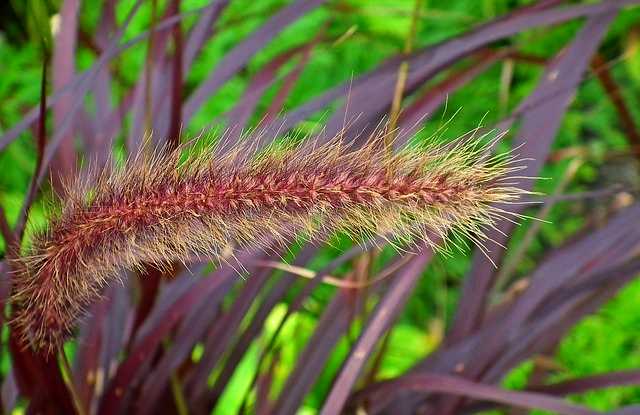
Ornamental grasses have become increasingly popular in modern garden designs due to their architectural beauty, texture, and versatility. Ranging from low-growing varieties to soaring species that can reach several feet tall, these grasses add movement and softness to landscapes. Planting ornamental grasses in the fall allows them to establish roots steadily, so they can thrive once the warmer weather arrives.
One of the advantages of ornamental grasses is their ability to adapt to various soil conditions and climates, making them suitable for a wide range of gardens, including xeriscapes and naturalistic settings. Many species, such as Miscanthus, Panicum, and Pennisetum, are drought-tolerant and can provide year-round interest with their graceful form and feather-like flower plumes.
In addition to their aesthetic appeal, ornamental grasses serve a functional purpose in the garden. They can help stabilize soil, reduce erosion, and attract beneficial wildlife such as birds and insects. Their dense foliage provides shelter for small creatures, while the seeds can offer a food source for birds during the colder months.
When incorporating ornamental grasses into your garden, consider staggering heights and colors for a dynamic visual effect. Mixing different varieties can create a layered look, making any outdoor space feel more inviting. Furthermore, many grasses turn brilliant shades of gold, red, or brown in the fall and winter, ensuring that your garden remains visually engaging even in the off-season.
Parrot Tulips
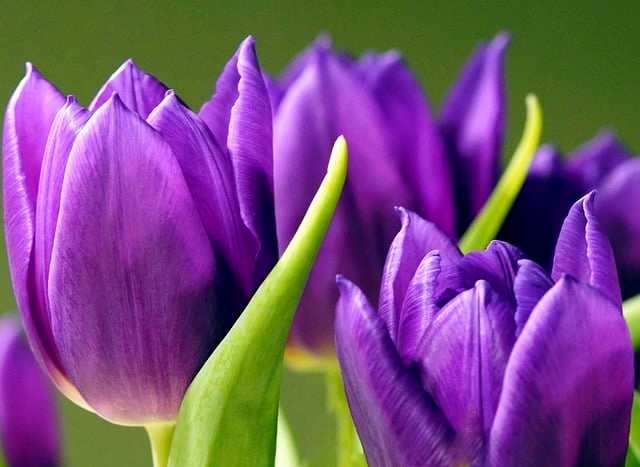
Parrot Tulips (Tulipa genus) are among the most flamboyant and striking tulip varieties available, known for their unique fringed petals that resemble feathers. These exotic blooms come in a dazzling array of colors, including vibrant reds, yellows, and purples. Planting Parrot Tulips in the fall allows the bulbs to root properly before winter, resulting in a dazzling display of blooms that brighten up the garden as spring approaches.
These tulips thrive in well-drained, fertile soil and require a sunny location to flourish. A planting depth of about 6 to 8 inches is ideal, allowing them to establish themselves well below the frost line. When grouped together, Parrot Tulips can create a breathtaking tapestry of colors in the spring months, making them an excellent choice for flower beds, borders, or even as cut flowers for arrangements.
Parrot Tulips not only enhance the beauty of your outdoor space but also attract early-season pollinators, such as bees, eager for nectar when other flowers are still dormant. Their unique appearance also makes them a favorite among floral designers, as they add drama and elegance to arrangements.
One of the appealing aspects of Parrot Tulips is their ability to create a sense of whimsy in the garden. Because they come in various forms and colors, they can be used to inspire playful combinations with other spring-blooming bulbs or evergreen foliage. Consider mixing them with traditional tulip varieties or planting them alongside fragrant perennials to enhance their visual impact.
Peony
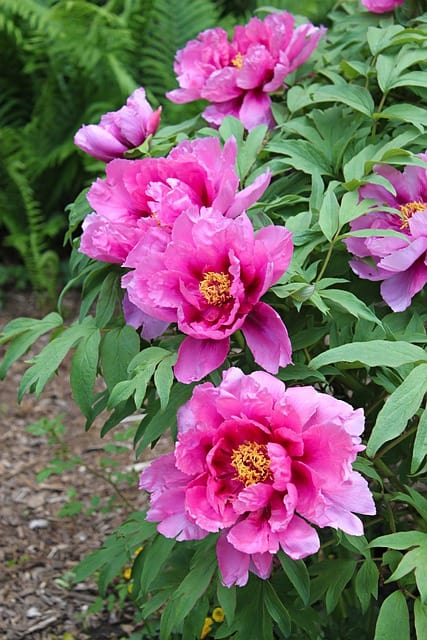
Renowned for their lush blooms and delightful fragrance, Peonies (Paeonia) are a classic perennial plant that many gardeners cherish. Known for their large, blousy flowers that can come in a variety of colors, including soft pastels, bold reds, and pure whites, Peonies are usually eagerly anticipated as they herald the arrival of late spring. Planting Peonies in the fall gives them ample time to establish their roots in the cool soil, which can lead to bigger and more vibrant blooms in the following season.
Peonies do best in well-drained, rich soil and thrive in full sun, although they can tolerate some light shade. When planting Peony roots, place them at a depth of around 1 to 2 inches beneath the soil surface, as planting them too deep can hamper their ability to bloom. Once established, Peonies are known for their longevity, often surviving and thriving for decades with minimal care.
In addition to their beauty, Peonies have cultural significance in many regions, symbolizing prosperity and good fortune. They are cherished not only for their stunning flowers but also for their lush, dark green foliage, which adds texture and depth to gardens throughout the growing season.
One of the remarkable features of Peonies is that they make excellent cut flowers, lasting well in arrangements and filling homes with their sweet scent. To extend their blooming period, consider pairing them with late-spring and early-summer perennials that can complement their lush display.
When planning your garden, be sure to give Peonies enough space, as they can grow fairly large,
Phlox
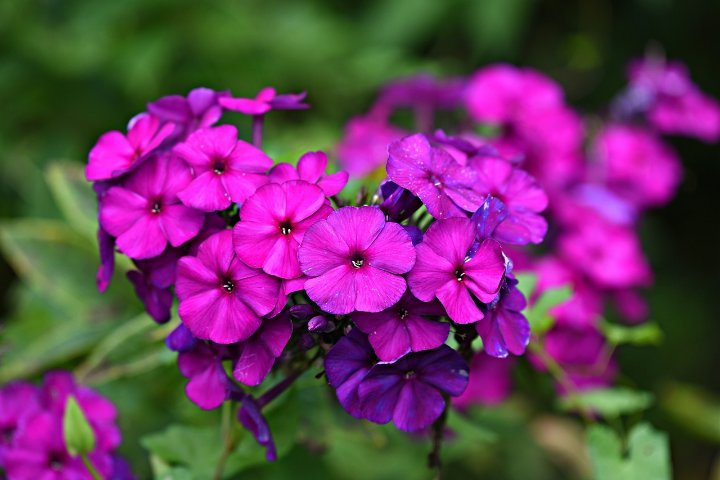
Phlox is a versatile perennial that brings a splash of vibrant color and delightful fragrance to gardens. With varieties ranging from low-growing ground covers to tall garden phlox, these hardy plants bloom in a stunning array of colors, including pink, red, white, and lavender. Planting Phlox in the fall allows these perennials to establish their root systems, ensuring a bountiful display when they wake from dormancy in early spring.
One of Phlox’s most appealing features is its ability to attract pollinators. Their sweet nectar draws butterflies, bees, and other beneficial insects, making them a staple in pollinator gardens. The blooms typically last for several weeks, providing an essential food source during the crucial spring and summer months.
Phlox prefers well-drained soil and thrives in full sun to partial shade. They are often used in cottage gardens or mixed perennial borders, providing contrasting heights and colors that create visual harmony. Given their drought-tolerant nature once established, Phlox offers a sustainable option for reducing water consumption in landscapes.
Moreover, Phlox can tolerate various soil types, making it adaptable for diverse garden settings. Regular deadheading encourages reblooming, prolonging the flowering period and enhancing the plant’s overall aesthetic. The lush foliage and bright flowers of Phlox create a stunning contrast, especially when planted alongside early spring-blooming bulbs or evergreens, ensuring a captivating garden through various seasons.
Pink Muhly Grass
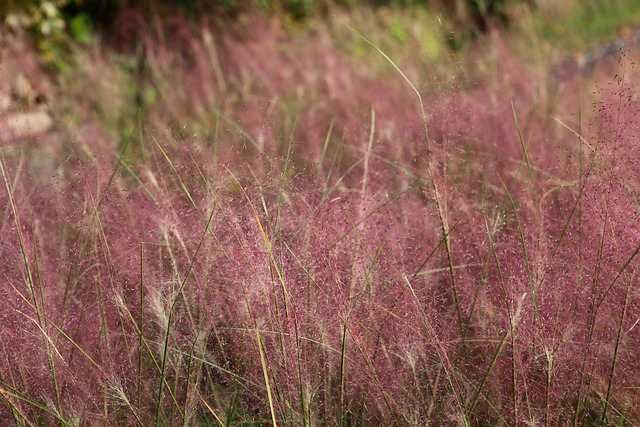
Known for its ethereal beauty, Pink Muhly Grass (Muhlenbergia capillaris) adds a unique texture and movement to gardens with its fine, feathery flower plumes. This ornamental grass typically blooms in late summer to early fall, showcasing fluffy pink tufts that dance gracefully in the breeze. Planting Pink Muhly Grass in the fall allows the roots to become established, readying the plant to display its magnificent blooms in the following season.
This grass thrives in full sun and is remarkably drought-tolerant, making it a sustainable choice for water-wise gardens. Pink Muhly Grass is adaptable to a variety of soil types, including sandy or clay soils, making it suitable for both coastal and inland landscapes. It can reach heights of 3 to 4 feet when in bloom and adds an appealing vertical element to borders and backgrounds.
Beyond its visual appeal, Pink Muhly Grass provides habitat for small birds and pollinators, supporting local ecosystems. The graceful shape of its plumes and foliage complements various planting styles, including modern, minimalist, or cottage gardens. It can be particularly striking when planted alongside other perennials, such as asters or late-blooming sunflowers, creating a harmonious palette.
In addition to its beauty, Pink Muhly Grass is low-maintenance, requiring minimal pruning. Cut back the foliage to a few inches above ground in late winter or early spring to encourage fresh growth. This plant not only enhances the landscape but also adds year-round interest, as its dried flower plumes can provide winter structure and beauty.
Purple Coneflower

Purple Coneflower (Echinacea purpurea) is a beloved perennial that captivates gardeners with its striking daisy-like blooms and medicinal properties. These resilient flowers bloom from mid-summer to early fall, showcasing their vibrant purple petals and prominent orange central cones. Planting Purple Coneflowers in the fall allows them to establish a strong root system before winter, leading to a dynamic floral display in the warmer months.
Renowned for their adaptability, Purple Coneflowers thrive in a variety of soil types, as long as the soil is well-drained. They prefer full sun but can tolerate partial shade, making them versatile choices for different garden locations. Additionally, once established, they are drought-tolerant, requiring minimal irrigation and making them perfect for low-water gardens.
Beyond their decorative appeal, Purple Coneflowers are known for attracting an array of pollinators, including bees and butterflies, which is essential for maintaining a healthy garden ecosystem. Their seed heads also provide nourishment for birds during the fall and winter months, adding an element of wildlife support to your garden.
These perennials can grow to a height of 2 to 4 feet, making them excellent for mixed borders, wildflower gardens, or even as standalone focal points. They can also create stunning contrasts when planted alongside ornamental grasses or other perennials with contrasting colors and textures.
To keep them blooming strongly, ensure regular deadheading of spent flowers throughout the season, which encourages more blooms and a longer flowering period. Purple Coneflowers also thrive on neglect, making them ideal for busy gardeners who appreciate stunning blooms without the intensive maintenance.
Rhododendrons
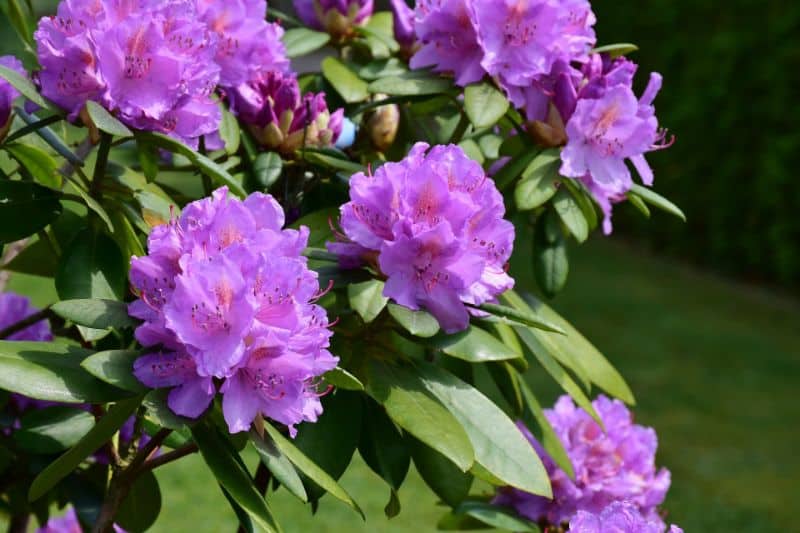
Rhododendrons are among the most majestic and iconic perennial plants, known for their dramatic clusters of blossoms and glossy green leaves. These evergreen shrubs come in various shapes and sizes, with flower colors ranging from pale pinks to fiery reds and deep purples. Planting Rhododendrons in the fall is advantageous, as it allows them time to establish roots before the harsh winter conditions set in. The cooler temperatures and increased rainfall make fall an optimal time for planting, reducing transplant stress.
Rhododendrons thrive in acidic, well-drained soil and prefer partial shade to full sun, making them ideal for woodland gardens or as foundation plantings. They can act as beautiful focal points in landscape design, particularly when planted in groups or mixed with other shade-loving perennials. Their lush foliage provides year-round interest, and they make fantastic backdrops for seasonal flowers.
In addition to their stunning beauty, Rhododendrons are known for attracting hummingbirds and other pollinators. This ability not only enhances the ecological value of your garden but also creates a lively atmosphere filled with the sounds and sights of nature. When considering companion plants, consider pairing Rhododendrons with ferns or hostas, which complement their growth habits and thrive in similar conditions.
To ensure your Rhododendrons perform their best, it is important to mulch around their base to conserve moisture and protect roots during extreme temperatures. Additionally, they can benefit from regular pruning to maintain their shape and encourage more abundant blooms in the spring.
Roses

Roses are timeless perennials that add elegance and fragrance to any garden. With an astonishing variety of species and hybrids available—ranging from climbing roses to compact ground covers—these beloved plants can fit almost any garden space. Planting roses in the fall provides them an opportunity to settle in before winter dormancy, so they can emerge strong and healthy in the spring.
Roses prefer well-drained soil enriched with organic matter, and they thrive in full sun, needing at least six hours of sunlight each day for optimal blooming. When selecting roses for your garden, consider varieties suited to your climate and hardiness zone, as some may require more care and protection than others. From the classic Hybrid Tea to vigorous Knock Out roses, there is a perfect option for every gardener’s aesthetic.
Beyond their enchanting beauty, roses are also known for their extensive blooming periods, often extending from late spring to frost. With proper maintenance—such as deadheading spent blooms, checking for pests, and ensuring adequate watering—gardeners can enjoy a continuous display of vibrant flowers.
Moreover, roses symbolize romance and beauty, making them popular for creating memorable gardens. For a stunning visual effect, plant them alongside perennials that provide contrasting textures and colors, such as lavender or salvia. This combination can elevate the charm of any space, creating a harmonious and vibrant environment.
It’s essential to prepare the soil and ensure proper spacing when planting roses; good air circulation helps prevent fungal diseases. Consider adding a compost layer or organic mulch to help retain soil moisture and support healthy growth. Additionally, fall is an excellent time to apply a slow-release fertilizer to give roots the nutrients they need for their upcoming vigorous growth.
Russian Sage
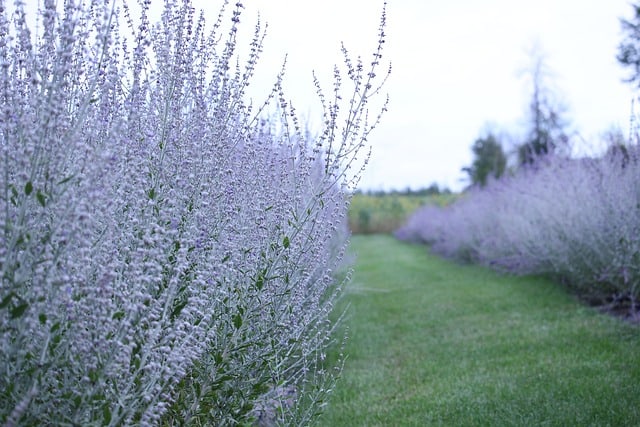
Russian Sage (Perovskia atriplicifolia) is a resilient perennial that adds an enchanting touch to gardens with its aromatic silvery foliage and airy lavender-blue flower spikes. A favorite among gardeners, this plant blooms from mid-summer to early fall, creating a soft, flowing look that works beautifully in borders, herb gardens, or as a backdrop for other colorful perennials. Planting Russian Sage in the fall allows the roots to acclimate to their new environment while taking advantage of cooler temperatures for optimal growth.
This perennial excels in well-drained, sandy, or rocky soils and requires full sun to flourish. Russian Sage is particularly celebrated for its drought tolerance, making it an ideal choice for low-maintenance gardening or xeriscaping. Its wiry stems and fine leaves provide outstanding contrast when paired with broader-leaved plants, while their elegant form adds structure and depth to any garden layout.
In addition to its aesthetic appeal, Russian Sage attracts pollinators, such as bees and butterflies, promoting biodiversity in your landscape. The plant is also deer-resistant and tends to have lower disease susceptibility, making it an excellent choice for gardeners seeking a reliable and enduring addition to their garden.
Sambucus (Elderberry)
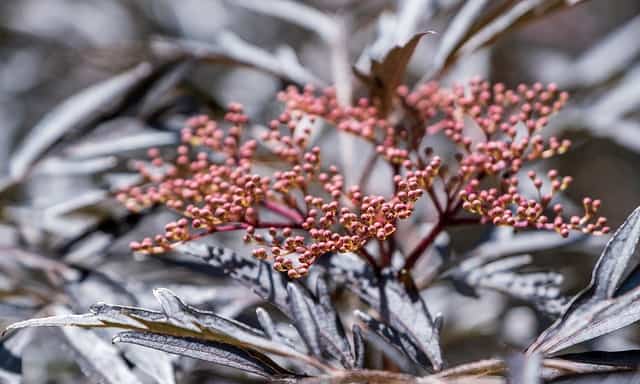
Sambucus, commonly known as Elderberry, is a versatile perennial that serves both ornamental and functional purposes in gardens. With its striking foliage and vibrant clusters of berries, Elderberry plants can add a lush, tropical feel to your landscape. Planting Sambucus in the fall allows these hardy shrubs to establish robust root systems, ensuring they are well-prepared for the following growing season.
Elderberries thrive in rich, moist, well-drained soil and can tolerate partial shade to full sunlight. They often grow to a substantial size, making them suitable for use as a screen or informal hedge. The large, fern-like leaves provide an eye-catching backdrop to any garden, while the creamy-white flower clusters that bloom in late spring to early summer attract a variety of pollinators, including bees and butterflies.
One of the most enticing features of Sambucus is its fruit. The berries, which appear in late summer, are not only visually striking but can also be harvested to make jams, syrups, and medicinal remedies (though they should be cooked before consumption, as raw berries and seeds can be toxic). This functional aspect makes Elderberry a valuable addition to any eco-conscious garden.
In terms of maintenance, Sambucus requires periodic pruning to maintain its shape and promote healthy growth. The fall planting season provides an excellent opportunity to establish these plants, as it’s easier for them to acclimate before the colder months. With its ornamental beauty and culinary uses, Sambucus stands out as an excellent perennial to plant this fall.
Schubertii Allium
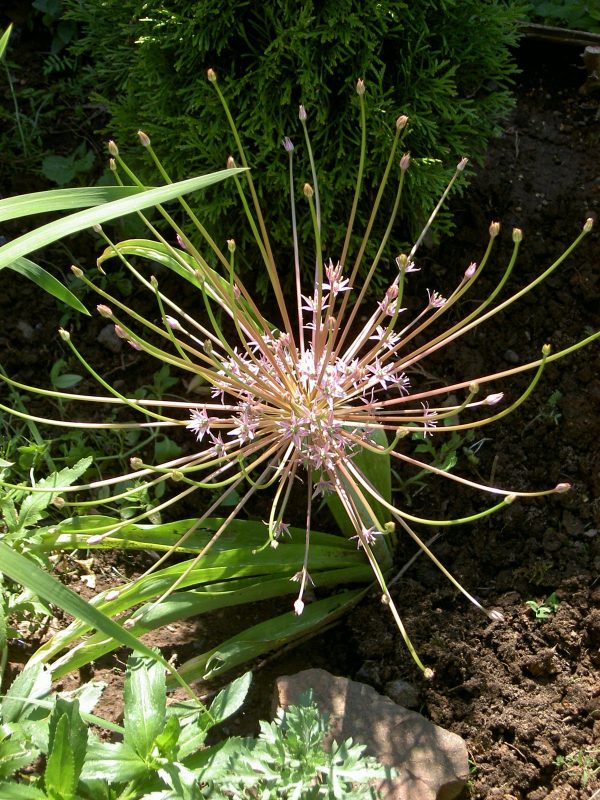
Schubertii Allium, or Allium schubertii, is a captivating and eye-catching perennial known for its unique, globe-like flower heads. Resembling fireworks on a stick, the large, spherical clusters of star-shaped flowers typically emerge in late spring to early summer, creating an impressive show in the garden. Planting Schubertii Allium in the fall allows the bulbs to settle into the soil and bloom vibrant and strong when the weather warms up.
This perennial thrives in well-drained soils and prefers full sun, making it an ideal option for rock gardens, borders, or even as specimen plants that command attention. The flower heads can reach up to 12 inches in diameter and stand tall on sturdy stems, often reaching heights of 24 to 36 inches. The distinctive shape adds a modern and architectural element to floral arrangements and garden designs.
Schubertii Allium is also known for its pest resistance and drought tolerance, making it a low-maintenance option for busy gardeners. The spent flower heads provide interest even after the blooming period, and the seed heads can be left in the garden to continue supporting birds throughout the winter months.
These bulbs can thrive in a variety of soil types, making them an adaptable choice for different garden environments. When planting Schubertii Allium bulbs in the fall, aim for a depth of about 6 to 8 inches to ensure they acclimate well to the changing temperatures. Consider grouping them in clusters for a more impactful display, allowing their unique shape to shine against other perennials.
Sedum
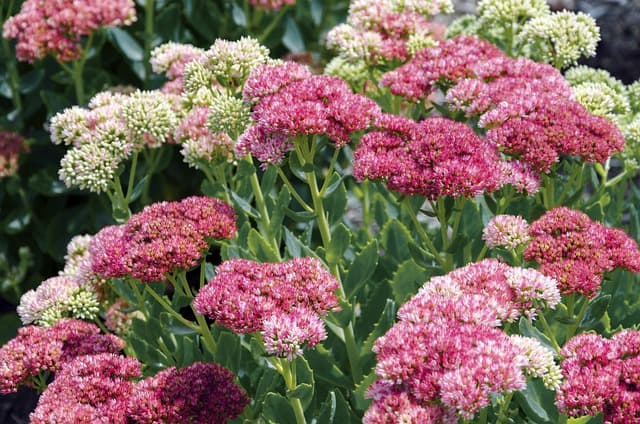
Sedum, commonly known as stonecrop, is a robust and resilient perennial that has become a favorite among gardeners and landscape designers alike. Renowned for its succulent leaves and drought-tolerant nature, Sedum comes in a variety of species and cultivars, offering an array of colors, shapes, and sizes. Planting Sedum in the fall gives these hardy succulents a head start, allowing their roots to establish before winter sets in.
These plants are exceptionally adaptable and thrive in well-drained soil, making them ideal for rock gardens, borders, and even rooftop gardens. They prefer full sun and can tolerate poor soil conditions, making them a perfect choice for low-maintenance landscapes. Sedum plants offer a wide palette of textures, from trailing species that cascade over rocks to upright varieties that create bold architectural statements.
Sedum’s resilience extends to its blooming period, with many species producing clusters of star-shaped flowers in late summer and early fall. These blooms attract butterflies and other pollinators, contributing to a healthy garden ecosystem. Moreover, Sedum’s fleshy leaves store water, making them drought-resistant and reducing the need for frequent watering once established.
Shasta Daisy
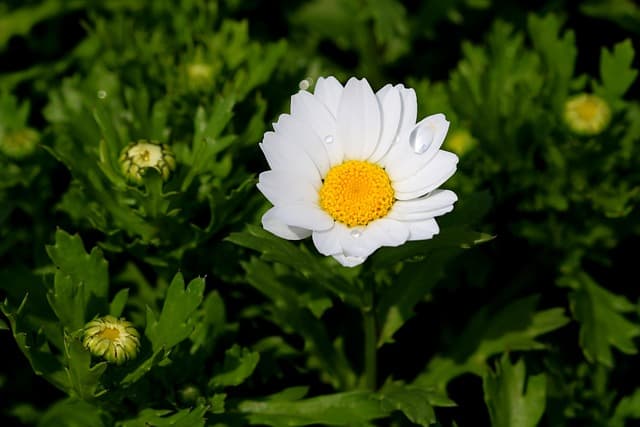
Shasta Daisies (Leucanthemum × superbum) are classic perennials that evoke a sense of cheerful simplicity in any garden. With their bright white petals and sunny yellow centers, these flowers create a striking contrast that brightens up borders and meadows. Planting Shasta Daisies in the fall allows their roots to establish in the cooler temperatures, leading to robust growth and an impressive floral display in summer.
These daisies thrive best in full sun and well-drained soil, making them suitable for various garden styles, from cottage gardens to formal landscapes. Once established, Shasta Daisies are relatively low-maintenance and can tolerate drought conditions, although they will reward gardeners with richer blooms with regular watering.
In addition to their aesthetic appeal, Shasta Daisies attract a host of beneficial pollinators, such as bees and butterflies, fostering a healthy ecosystem. When planted in groups, they can create a sea of white that sways gently in the breeze, providing an uplifting focal point in any garden.
For optimal growth, it’s a good practice to deadhead spent blooms throughout their flowering season to encourage repeat blooming and maintain a tidy appearance. After the first hard frost, Shasta Daisy foliage can be left to winter over, providing some winter interest and habitat for beneficial insects until spring.
Siberian Iris
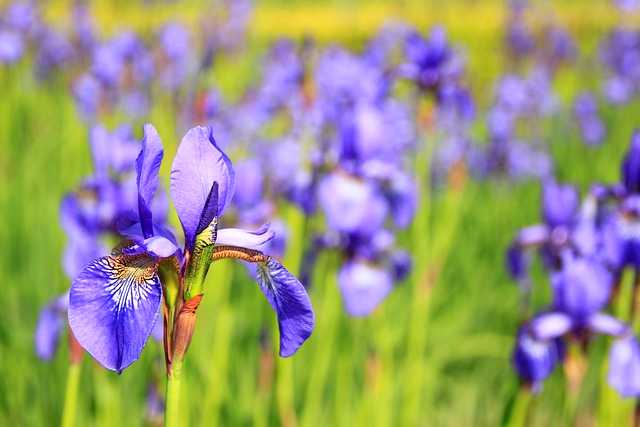
Siberian Iris (Iris sibirica) is a stunning perennial that adds a splash of color and grace to the garden. Renowned for its slender, arching leaves and delicate blooms, this iris variety flourishes in damp soil, making it an excellent choice for borders, rain gardens, or alongside water features. Planting Siberian Iris in the fall allows the rhizomes to settle into the soil, ensuring they develop a strong foundation for spectacular blooms in late spring to early summer.
These irises prefer full sun to partial shade and are highly adaptable, thriving in a variety of soil types as long as they are not waterlogged. Their flowers come in shades of blue, violet, white, and yellow, often with intricate markings, attracting pollinators and making them a delightful addition to mixed perennial gardens.
Beyond their beauty, Siberian Irises are known for their resilience. They can tolerate variations in both water and soil conditions, which makes them an excellent choice for less predictable weather patterns. Once established, these irises require minimal maintenance and can thrive for years without needing division. However, if you want to propagate your plants or encourage denser growth, dividing the clumps every few years can yield fantastic results.
For ideal planting, place Siberian Iris rhizomes just below the soil surface and be sure to keep the area well-watered until the plants are fully established. These irises add elegance and a splash of color to gardens, especially when combined with other moisture-loving perennials like Japanese Irises or Astilbes.
St. John’s Wort
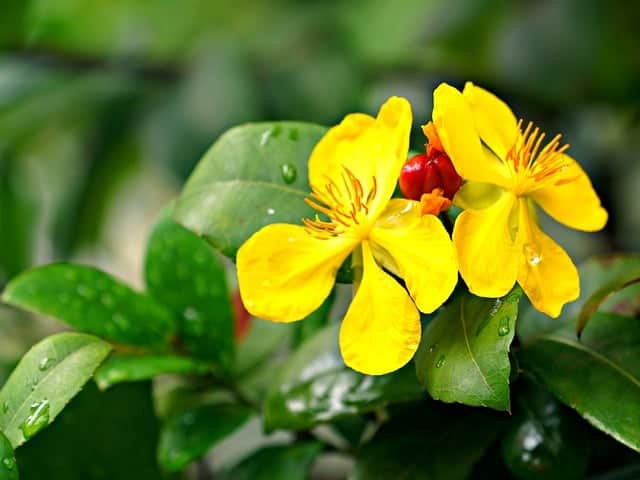
St. John’s Wort (Hypericum perforatum) is a hardy perennial known for its sunny yellow flowers and medicinal properties. This plant is often celebrated for its therapeutic uses, particularly in herbal medicine. When planted in fall, St. John’s Wort can develop a solid root system, allowing it to thrive before colder temperatures arrive and to burst forth with color in the summer months.
This perennial flourishes in a variety of soil types, from poor to nutrient-rich, and prefers full sun to partial shade. It is particularly well-suited for drier conditions, making it a great choice for drought-tolerant and low-maintenance gardens. The vibrant yellow flowers bloom from June to August and attract a variety of pollinators, particularly butterflies, to the garden.
In addition to its beauty and utility, St. John’s Wort can also play a role in soil improvement through its ability to grow in marginal areas. Its taproots assist in breaking up compacted soils, allowing other plants to thrive nearby. This makes it an excellent choice for wildlife gardens or naturalized areas.
When incorporating St. John’s Wort into your garden, consider using it alongside other perennials, such as Heliopsis or Coneflowers, which can attract even more pollinators and create a dynamic, engaging landscape. With minimal care, St. John’s Wort can bring a burst of color and a wealth of health benefits to your garden, making it a valuable addition to fall planting.
Stonecrop

Stonecrop, also known as Sedum, is a diverse group of succulents that are perfect for gardeners seeking low-maintenance and drought-tolerant plants. With their fleshy stems and leaves, Stonecrop varieties come in various shapes, sizes, and colors, making them versatile for almost any garden design. Planting Stonecrop in the fall allows these hardy plants to establish roots before the harsher winter weather, preparing them for a brilliant display in late summer and fall.
These perennials excel in well-drained, rocky, or sandy soils and thrive best in full sun, making them ideal for rock gardens, pathways, and container displays. Whether it’s the towering spikes of ‘Autumn Joy’ or the ground-hugging forms of creeping sedums, their varied textures and colors add distinctive layers to your landscape.
One notable benefit of Stonecrop is its ability to attract pollinators. During their blooming period, which often aligns with the end of summer, they serve as an essential food source for bees and butterflies, enhancing the biodiversity in your garden. Additionally, the drought resistance of Stonecrop makes it a perfect candidate for xeriscaping, allowing it to flourish even in dry spells.
Consider using Stonecrop in combination with other drought-tolerant plants like sage or lavender to create a vibrant, eco-friendly garden space. When planting, be mindful of spacing, as some Stonecrop varieties can spread aggressively. They are typically low-maintenance and only require occasional pruning to remove dead or damaged foliage, making them an ideal choice for busy gardeners looking for an easy-care option.
Thyme
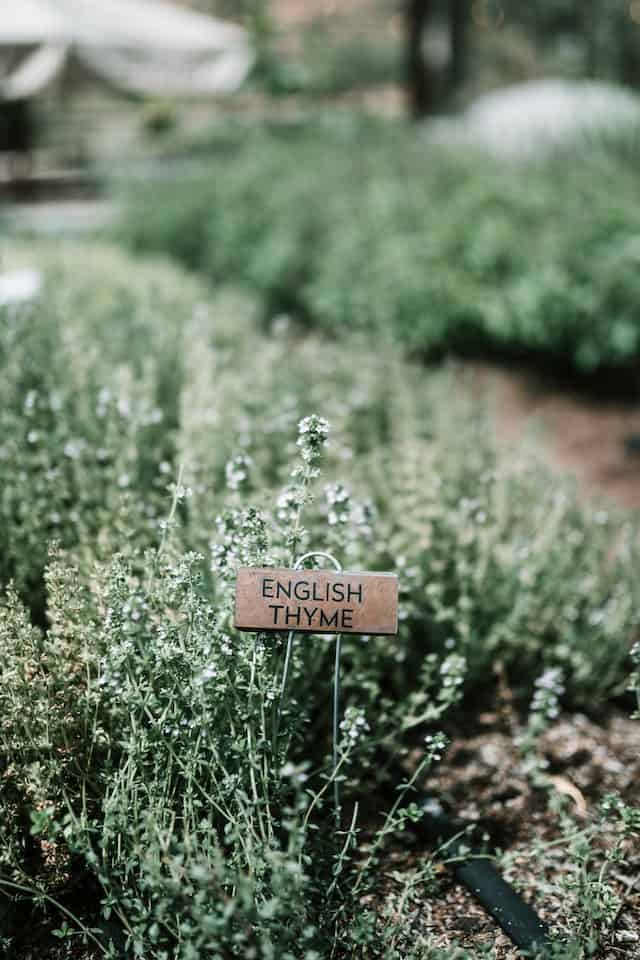
Thyme (Thymus spp.) is a delightful perennial herb that not only enhances culinary creations but also serves as a beautiful addition to flower beds and gardens. Known for its aromatic leaves and tiny clusters of purple flowers, thyme is best planted in the fall, allowing this hardy herb to establish itself before winter dormancy sets in.
This perennial thrives in full sun and well-drained soil, making it an excellent choice for rock gardens, herb gardens, or as ground cover. Thyme is particularly valued for its low-growing habit and resilience, making it ideal for edging pathways or filling in spaces between stepping stones. Varieties such as creeping thyme not only create a lush green mat but also release their delightful fragrance when stepped on, enhancing the sensory experience of your garden.
Beyond its culinary uses and charming aesthetic, thyme draws beneficial insects, such as bees, to the garden, contributing to pollination and biodiversity. The flowers, appearing from late spring through summer, attract butterflies as well, making for a lively garden scene.
When planting thyme, consider spacing the plants about 12 to 18 inches apart to allow for air circulation and growth. While thyme is drought-resistant once established, regular watering is essential during its initial growth period. Prune back old growth in late spring to encourage new, healthy growth. With its versatile uses and lovely appearance, thyme is an ideal perennial for those looking to add both function and beauty to their garden this fall.
Vervain
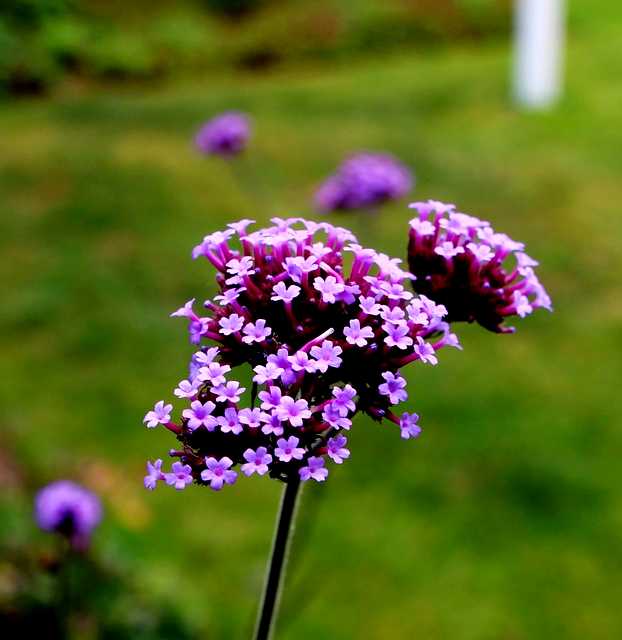
Vervain (Verbena) is a captivating perennial that boasts clusters of small flowers in vibrant colors, such as purple, blue, and white. Known for its graceful, airy appearance, Vervain is an excellent choice for adding vertical interest to flower borders and creating a relaxed, cottage-garden feel. Planting Vervain in the fall allows these plants to root deeply before winter, promoting healthy shoots in the coming spring and summer.
This perennial thrives best in full sun and well-drained, moderately fertile soil. Vervain is known for its heat and drought tolerance, making it suitable for gardens in warmer climates or those with occasional dry spells. Its upright growth habit, often reaching heights of 2 to 4 feet, makes it an ideal choice for the back of borders, where its blossoms can dance freely in the breeze.
In addition to its ornamental appeal, Vervain is prized for attracting pollinators, particularly butterflies and hummingbirds. The vibrant flower clusters provide nectar for these creatures, resulting in a lively and dynamic garden atmosphere on warm sunny days.
For optimal results, consider pairing Vervain with other sun-loving perennials, such as Coneflowers or Black-eyed Susans, which can create a stunning tapestry of colors and textures. When planting, be sure to space Vervain adequately to allow for air circulation and growth; a spacing of about 12 to 18 inches is advisable. With minimal maintenance required, Vervain offers a striking solution for gardeners looking to create a beautiful, pollinator-friendly environment.
Weigela
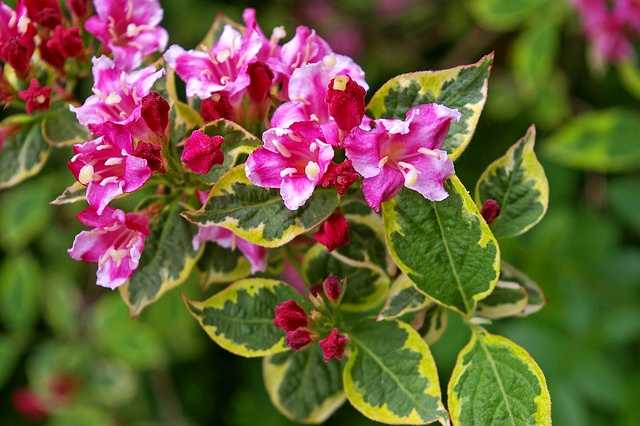
Weigela is a striking deciduous shrub that adds spectacular color and interest to any garden setting. Its funnel-shaped flowers bloom profusely from late spring to early summer, making it a vibrant choice for those looking to brighten up their landscapes. Depending on the cultivar, Weigela can display a palette of colors, including pinks, reds, and whites, making it highly versatile for various garden themes.
Planting Weigela in the fall is particularly beneficial because it allows roots to establish themselves during the cool, moist months, enhancing resilience against winter stresses. This hardy shrub thrives best in well-drained, loamy soils and enjoys full sun to partial shade. However, it does equally well with some afternoon shade, particularly in hotter climates.
Weigela is not only appreciated for its ornamental beauty; it also attracts numerous pollinators, including hummingbirds and butterflies, thanks to its nectar-rich flowers. This makes the plant an excellent choice for creating a garden that encourages wildlife interactions. Moreover, Weigela’s attractive foliage, often featuring variegated or deep burgundy leaves, offers visual interest even after the flowers fade.
When incorporating Weigela into your garden, consider pairing it with other perennials that have similar light and soil requirements, such as daylilies or hostas, to create a stunning mixed border. Weigela also benefits from regular pruning after flowering, which helps maintain its shape and promotes new growth for the following season.
Overall, Weigela is a wonderful addition for fall planting, offering color, pollinator attraction, and versatility within diverse garden styles—from formal hedges to relaxed cottage gardens.
Perennial Plants to Plant in Fall FAQ
Q: Why should I plant perennials in the fall instead of spring?
A: Fall planting allows perennials to establish strong root systems before winter, utilizing the cooler temperatures and extra moisture. This preparation often leads to healthier and more robust plants that can bloom vibrantly in spring and summer.
Q: What types of perennials can I successfully plant in fall?
A: Many perennials thrive when planted in the fall. Choices include Shasta Daisies, Siberian Irises, Rhododendrons, Roses, Russian Sage, Stonecrop, Thyme, Vervain, and Weigela, among others. Each species has varying preferences, so be sure to select those that suit your specific climate and soil conditions.
Q: How do I properly prepare my garden for fall planting?
A: To prepare your garden for fall planting, clear the area of weeds and debris. Test your soil’s pH and nutrient levels, and amend it if needed, ensuring that it’s well-drained and fertile. Additionally, when planting, create wide holes that accommodate the root systems and properly water the plants after planting to help settle the soil around them.
Q: Should I mulch after planting in the fall?
A: Yes, applying a layer of mulch is beneficial after planting perennials in the fall. Mulch helps retain soil moisture, suppresses weeds, and insulates the plants’ root systems against harsh winter temperatures. Use organic mulch, like shredded bark or straw, which will naturally decompose and improve soil health over time.
Q: How do I care for my newly planted perennials during winter?
A: Newly planted perennials may require some attention during winter, especially their first year. Ensure they receive enough moisture during dry spells in late fall. Once the ground freezes, protecting perennials with a layer of mulch can help shield them from temperature fluctuations and desiccating winds. Additionally, avoid heavy pruning in the fall; it’s best to wait until spring when new growth begins to appear.
Q: Can I plant perennials that I’ve grown from seed in the fall?
A: Yes, certain perennial seeds can be sown in the fall. However, it’s essential to read the seed packets for specific instructions regarding cold stratification and germination periods. Fall sowing can be effective for hardy species that can self-sow or germinate in the spring after winter conditions break the seed dormancy.
Q: Is there anything to consider regarding local climate when planting in the fall?
A: Absolutely! Local climate impacts both planting success and plant selection. Consider factors such as the average first frost date in your area and select perennials that are suitable for your hardiness zone. In warmer regions, you may have a longer window for fall planting than in colder climates.
By exploring Weigela and addressing common questions regarding fall perennial planting, we hope to inspire you to create a thriving garden that brings joy and beauty throughout the seasons. Embrace the opportunities that fall offers, and watch as your efforts culminate in a vibrant landscape in the months to come!


